Teaching Argumentation and Persuasion: 6 Engaging Activities Beyond the Argumentative Essay
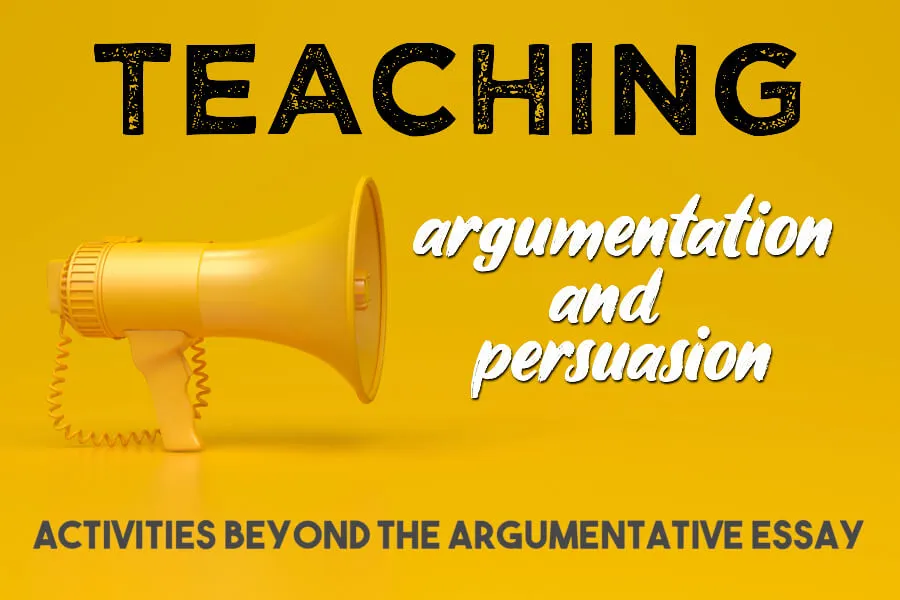
There are many engaging activities to use when teaching argumentation and persuasion beyond the classic essay. While the argumentative essay can certainly be effective, try something new with one of these 6 engaging activities. Your students will be excited and eager to apply argumentation and persuasion in the classroom and beyond.
When it comes to teaching argumentation and persuasion, I’m like a kid on Christmas morning. I’m eager, excited, and full of energy. Yet, over the years, I’ve found that my students don’t always meet me with the same enthusiasm. Instead, they roll their figurative eyes at the thought of writing yet another essay.
I had to do something to save my favorite holiday– I mean unit– of the year.
I’ve spent more hours than I’d like to admit, wracking my brain for activities that would make teaching argumentation and persuasion, dare I say, fun! But the time and effort paid off. When I started implementing activities beyond the argumentative essays, my students were engaged and active participants. It was a win-win.
Lucky for you, I’ve done the work (and put in the time) so you don’t have to. Instead, simply keep reading to uncover some of my secret weapons for teaching argumentation and persuasion. The following activities can be used instead of or in conjunction with the classic argumentative essay. It’s totally up to you and what will best suit your students’ needs. Regardless, you don’t have to spend the hours brainstorming from square one. You can thank me later. In the meantime, read on, my teacher friends!

Laying the Foundation for Teaching Argumentation and Persuasion
Before jumping into one of the activities below, you need to set your students up for success. Therefore, be sure to teach the essential concepts for effective argumentation and persuasion. Afterall, both argumentation and persuasion are cornerstone communication skills in the 21st century.
So, not only do you want to do these topics justice for the sake of your classroom. But, they’re also some of the most transferable skills your students will use in the real world.
Note: if you’re just looking for the activities, no problem! Keep scrolling– I promise they’re there.
Understanding the Difference Between Argumentation and Persuasion
While these two topics are often taught together, it’s important for students to know that they aren’t exactly synonyms. Instead, you could argue (see what I did there) these two concepts act as compliments to one another. In many cases, persuasion can strengthen an argument, and vice versa. But again, they’re not exactly the same when it comes to speaking or writing. (However, I find it useful to remind students of one of the most important aspects they do share: there has to be at least two sides.) You can clarify the major differences between the two by looking at the main goal for each type of writing or speech:
- The goal of argumentative writing is to get the audience to acknowledge your stance on a topic. Moreover, a strong argument shows the reader your viewpoint is valid and deserves consideration. Therefore, argumentative writing is heavily rooted in logic and facts and addressed counterclaims.
- Goal of persuasive writing is to get the audience to agree with you and your stance on a particular topic or viewpoint. While logic most certainly strengthens persuasion, there is also a heavy emphasis on emotional elements as well.
The truth is, the two are often used hand in hand in the real world with everything from marketing and public service campaigns to politics and law. And, in most cases, persuasive writing is more personal and passionate for students. Therefore, I strive to teach the two together to increase student engagement and real word application. Talk about a dream duo for students and teachers alike!
Rhetoric and Rhetorical Appeals
I absolutely love comparing persuasion and argumentation to art. Why? Because it’s a true craft. Do I explain it that way to my students? Abso-freakin-lutely. Why? Because they need to understand that presenting a sound and persuasive argument is a skill. That these writing and speaking skills take time and effort to develop.
Enter: Rhetoric. I always begin this unit by defining argumentation, persuasion, and rhetoric, explaining how the latter literally means the art of persuasion. Then, I introduce the three main rhetorical appeals (shout out Aristotle). Rather than simply giving the students the definitions of ethos, pathos, and logos, I begin by asking questions to help reveal the definitions. Here are some of the questions I use– and that you can most certainly steal for your own classroom:
- To introduce ethos , I ask, “Who would you trust to give advice about toothpaste? Why?”
- To introduce logos , I might ask, “If you wanted to learn how to build a successful business, what is the benefit of a successful entrepreneur giving you step-by-step guidance?”
- To introduce pathos , I ask, “Think about a time where you got emotional during a commercial, song, or movie. What was it that made you so emotional?”
The Power of Words
Once students have an understanding of these essential definitions, it’s time to move on to a more abstract, yet highly significant, concept: the power of words. This is where I introduce the importance (and power) of diction. This is the perfect time to explain how words impact reader/audience experience.
One of the simplest examples to make a case for this claim is asking students to analyze the difference between the terms house and home. I’ve never had a class not come to the conclusion that a house is a structure and place of living, where a home is a place filled with love.
To round out the discussion on why and how words have an impact on the audience, introduce connotation and denotation. Spending a handful of minutes explaining the emotional meaning behind words (connotation) can be a game changer. It reminds students that there is, in fact, emotional power in the words we use. To drive the point home, you can ask them to compare times when they were upset vs. angry vs. furious.
A Fun and Engaging Warm-Up Activity for Teaching Argumentation and Persuasion
What tween or teen doesn’t like arguing with adults? (Trust me. They’re far and few between.) In other words, students will eat this activity up. Rather than focusing on deep and heavy topics that require a great deal of research and unpacking, this activity is a lighthearted warm-up. The goal is to get students to start thinking about what goes into a sound and persuasive argument.
- Arguing with “Adults”
Working independently or in small groups, students will pick a “silly” or lighthearted topic. Encourage them to think of things they’d like to convince their parents, teachers, or other adults. Since these topics are light hearted and often come from a place of passion, students will have no problem coming up with reasons why their curfew should be extended by an hour or two or why homework should be abolished. They’re excited to argue why their parents should buy them a car or why a puppy is a must-have addition to their family.
Next, allow students five minutes to choose a topic and brainstorm their argument. Then, give them 10-20 minutes to write their argument. (The timing of this activity is flexible, so you can adjust it based on the structure of your class.) After they write out their argument, it’s time to share– and let the discussion unfold. As each student (or group) shares their argument, have fun playing devil’s advocate. Challenge them to push their arguments and reasoning further.
While you might want to guide the students through the discussion, let them really come to terms with the idea of what makes a sound and persuasive argument. And if you really want to play up the fun? Challenge the other students to play that role! Have your students in the audience play the role of the adults to whom the argument is targeted. This will challenge students to find holes in the arguments, brainstorming ways to make an argument even stronger. Additionally, it challenges them to think about the importance of audience perspective , looking beyond their own interests, blind spots, and biases. The end result? Develop a list of student generated “check-points” for an argument that is both powerful and persuasive.
Engaging Activities for Teaching Argumentation and Persuasion
Watching TV. Driving down the highway. Scrolling through social media. The art of argumentation and persuasion are everywhere . So, why not bring some of those real-life examples to your classroom? Because the truth is, persuasion and argumentation comes in all shapes and sizes. Therefore, it might be time to look beyond the traditional argumentative essay. And with these activities, you can.
An oldie but a goodie. In fact, discussing teaching argumentation and persuasion wouldn’t feel right without some sort of debate. So, to begin this student-centered activity, select (or have students choose) a topic to argue. This can be a murder or crime– and you can even have fun with historical topics like the Salem witch trials if it’s around Halloween or you’re reading The Crucible . Alternatively, you can root your debate in an ethical dilemma or an essential question. Generally speaking, you can look toward real life events or literature for inspiration. You can even head to your state bar association website for mock trial resources and cases– like these from the state of NH . As long as there is evidence to be found and a case to make, you should be good to go.
Before really diving into the mock trial, spend time reviewing the basics of the justice system and trials. Then, once you choose your topic, divide students into teams of prosecution and defense. Once the teams are determined, students can dive into researching and crafting their arguments. However, be sure to emphasize the need for evidence based claims while also discussing the power of persuasion in the courtroom. (There are plenty of video clips you can show and analyze to see these two elements in action.) Each group, both the prosecution and defense, are responsible for crafting an opening statement, a claim, a rebuttal, and a closing statement. For smaller classes, you can serve as the judge and jury. For larger classes, you can run several trials, letting the other groups act as the jury if they’re not presenting. Either way, students will be far more eager to win the jury over with their evidence than they are to write a paper.
There’s no better way for students to show off their new persuasive skills and knowledge of ethos, logos, and pathos than to craft their own arguments. And a mock trial allows them to do so in a way other than the classic essay. But with a verdict on the line, there’s a lot at stake. Therefore, this activity amps up eager participation.
Mock Trial Teacher Tip. Mock trials make debating more exciting– especially if you really play up the trial theme. (Have an old graduation gown? Use it as the judge’s robe! A wig? Yes please! A gavel? A must.) So, grab your gavel and give this engaging activity a try!
- Students Do Shark Tank
This activity brings the worlds of business, marketing, and advertisements into the conversation. Talk about real world connection! Most older students will be familiar with this show. However, it’s always fun to show a clip for an episode or two just in case. Plus. Who doesn’t love watching videos in class? (Teachers and students alike.) Shark Tank is all about the pitch. So, have fun replicating this idea in your classroom! And instead of presenting to the likes of Mark Cuban, students will present to you . If you’re able, try getting a few other guest sharks on the “show”.
Before diving into the project, in addition to watching a few clips of the show, take some time to analyze the world of advertising. Encourage students to find connections between argumentative and persuasive writing and real-life commercials, social media campaigns, and print advertisements. Then, put students in small groups and together they will create their own product. Alternatively, you can have them pick an existing product they’re passionate about. Then, the fun begins.
Using their new knowledge of persuasive language techniques and argumentation, students must convince the sharks to invest in their product! For a fun twist that gets everyone involved, let the audience in on the investments. Print out a set amount of “money” for each student. After all the presentations, allow them to “invest” in their favorite products. As for the presentations themselves, I like to require a visual advertisement– like a poster– and a written component– like an elevator pitch. Students can then display their visuals as they give their speech. Later, students can view all of the visuals as they decide where to “invest” their money.
Shark Tank Teacher Tip. Looking to beef up the argumentative writing side of things? You can have students submit a short research-based argumentative paper that supports the need for their product. Regardless of the specifics, students will be eager to dive into this activity with such real world application.
- Speech Remix
From Abraham Lincoln’s “The Gettysburg Address” and Martin Luther King Jr.’s “I Have a Dream,” history has its fair share of powerful speeches. And they’re great examples of argumentation and persuasion as well. So, begin this activity by analyzing a mentor text as a class. Then, turn it over to the students to showcase their knowledge on their own.
Have students choose a historical speech (you can refer to this bank of speeches here ) to analyze. They can turn in annotations or a short response analyzing the rhetoric of their chosen speech. Here’s the twist. After analyzing the speech, they then use it as a mentor text, implementing its sentence structure, tone and rhetorical techniques as they write their own speech. This is where student choice really kicks up a notch. Allow students to choose a topic, cause, or issue they feel passionate about. However, I always recommend having a list of potential topics on hand for students who need a little more guidance.
Additionally, it might be useful to encourage a backwards design approach. Have students select their topic first, and then find a speech that is a good match. For example, a social justice issue might pair well with Martin Luther King Jr.’s “I Have a Dream” speech. However, be sure students choosing unique and more modern topics are not dissuaded if they can’t find the perfect match. Regardless, in the end, this activity pays homage to great speeches of the past while allowing students to take ownership as they apply the argumentative and persuasive techniques to modern day.
Speech Remix Teacher Tip. Why limit yourself to the four walls of your classroom? This activity is a perfect opportunity for cross-curricular collaboration. Consider reaching out to the history teachers and focus your class study on a speech that lines up with the social studies curriculum. This will allow students to have a more in depth background knowledge, giving them more context for the speaker’s rhetorical approach. Similarly, a speech of this caliber might be less intimidating if they understand the context, allowing them to really focus on the rhetorical approach.
- #Influencer
In the age of social media, companies make a pretty penny using influencer campaigns. And it’s really quite fitting. Afterall, argumentation and persuasion is all about influence . So, to kick off this activity, spend some time looking at social media ads and influencer accounts. Be sure to analyze everything from photos to captions to hashtags.
After looking at real word examples, it’s time for students to take on the role of an “influencer” – they can be themselves or create an influencer persona. The next step is for them to choose which product of service they are “fit” to promote and, ideally, sell. Students should pick something they have experience with or knowledge about, from video games to make-up. Then, have students write a letter to the “company” (aka you) to convince them that they are capable of being an influencer. This is where they really need to tap into ethos. They should clearly explain why they are a reputable source and should be trusted to sell “your” product. If they’ve convinced you, then they can sign a “contract” (aka the assignment requirements) that outlines the agreement.
Here’s where the fun and creativity happens. While you can determine the specific requirements, students should create a portfolio of campaign materials to promote their chosen product. This is where you can determine how in depth or brief you want the assignment to be. The portfolio can include artifacts like a series of social media posts, youtube videos or scripts, an email funnel, or even blog posts– or a portfolio combining various types of artifacts.
#Influencer Teacher Tip. If you’re looking to amp up the requirements and turn this into a unit-long assignment or a full blown summative assessment, you totally can. Consider adjusting the assignment to be a multigenre project of sorts. Present students with a list and overview of various genres they can include as part of their project. Then, let them select the ones they wish to include in their multigenre portfolio.
- PSA – The Passion Project
The name alone screams engagement, right? Even better, this activity is engaging. Instead of assigning a list of overused (and sometimes outdated) argumentative prompts, let students take the reins by choosing a topic that matters to them . So, after teaching your students about rhetorical appeals, the appropriate use of persuasion, and the basics of argumentative writing, let students showcase their newfound skills with the PSA Passion Project. In this project, rather than simply writing an essay for the sake of getting grades, students are diving into an issue of their choice in hopes of raising awareness.
Begin by having students select a social or environmental issue that is important to them. These can range from animal testing in the beauty industry to the impact of social media on mental health. In other words, there’s a wide variety of topics out there, so your students are bound to find something that matters to them. Then, they must plan, develop, and create a public service announcement campaign around the issue. This is where you can really drive home the idea of call to action with persuasion. The challenge with the PSA assignment is crafting an argument that is applicable and persuasive for a mass audience. Afterall, when it comes to wide-spread change, there is power in numbers. (This activity can serve as its own unit or work in conjunction with the study of classic essays like “On The Duty of Civil Disobedience” by Thoreau or “A Letter From Birmingham County Jail” by MLK Jr..
This activity has plenty of room for creativity and student choice. However, that doesn’t mean you have to give up a writing component. Instead, require students to complete a minimum of two items: a written piece and a visual or media element. The writing pieces can range from a more traditional argumentative essay to back up their media component. Alternatively, they can write a speech, persuasive letter, or educational blog post. Then, for the media components, they can create a poster, a video, a social media post, or an infographic– just to name a few. Now, if you’re really looking to diversify the elements of this project, consider turning the PSA Passion Project into a full blown multigenre project!
PSA Passion Project Teacher Tip. Despite your best efforts, some students will claim they can’t find a topic they’re passionate about. (Teenagers.) That’s why I always come prepared with a list of topics students can choose from. Even students eager to choose their own topic might like to see a list for inspiration. Save yourself some time by giving them ideas from this list of engaging argumentative writing prompts!
A Final Note on the Art of Teaching Argumentation and Persuasion
Remember, I’m not saying traditional essays are bad. But I think it’s worth looking beyond the traditions and asking ourselves, how can we make this better ? Better for the students. More reflective of and applicable to the world we live in. If there’s some fun to be had along the way, so be it! (In fact, I encourage it!)
So, as you go one to try any one (or all!) of these activities in your classroom, feel free to make adjustments as needed. And If you’re still looking for a more traditional essay to be your summative assessment, that’s A-OK too! In fact, the activities above can be shortened and adjusted to serve as a mini-lesson or formative assignments before writing a more traditional argumentative essay.
The bottom line is this…
Ever since I changed my approach to teaching argumentation and persuasion, it’s become something my students and I enjoy together . Imagine that!
1 thought on “Teaching Argumentation and Persuasion: 6 Engaging Activities Beyond the Argumentative Essay”
awesome advice and ideas. My semester just got a lot better!!!
Leave a Reply Cancel reply
Your email address will not be published. Required fields are marked *
Save my name, email, and website in this browser for the next time I comment.
Persuasion Map
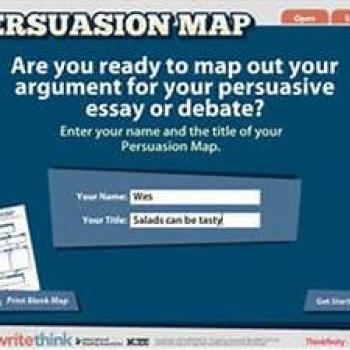
About this Interactive
Related resources.
The Persuasion Map is an interactive graphic organizer that enables students to map out their arguments for a persuasive essay or debate. Students begin by determining their goal or thesis. They then identify three reasons to support their argument, and three facts or examples to validate each reason. The map graphic in the upper right-hand corner allows students to move around the map, instead of having to work in a linear fashion. The finished map can be saved, e-mailed, or printed.
- Student Interactives
- Strategy Guides
- Calendar Activities
- Lesson Plans
The Essay Map is an interactive graphic organizer that enables students to organize and outline their ideas for an informational, definitional, or descriptive essay.
This Strategy Guide describes the processes involved in composing and producing audio files that are published online as podcasts.
This strategy guide explains the writing process and offers practical methods for applying it in your classroom to help students become proficient writers.
Through a classroom game and resource handouts, students learn about the techniques used in persuasive oral arguments and apply them to independent persuasive writing activities.
Students analyze rhetorical strategies in online editorials, building knowledge of strategies and awareness of local and national issues. This lesson teaches students connections between subject, writer, and audience and how rhetorical strategies are used in everyday writing.
Students examine books, selected from the American Library Association Challenged/Banned Books list, and write persuasive pieces expressing their views about what should be done with the books at their school.
Students will research a local issue, and then write letters to two different audiences, asking readers to take a related action or adopt a specific position on the issue.
- Print this resource
Explore Resources by Grade
- Kindergarten K

5 Top Persuasive Writing Lesson Plans for Students and Teachers
The purpose of any persuasive writing text is to persuade the reader of a particular point of view or to take a specific course of action. Persuasive texts come in many different forms, including, but not limited to, essays, editorials, letters, advertisements, and reviews. While persuasive texts come in many shapes and sizes, they all share standard features.
Persuasive texts employ a wide variety of different rhetorical strategies and techniques to achieve their ends. For example, they’ll use emotive language and rhetorical questions. Images are sometimes used to entice or appeal to the reader or viewer.
Advertising is one key form of persuasive writing . It makes vigorous use of all the tools in the persuasive writing toolbox as it strives to sell goods or services to the reader.
In this article, you’ll learn how to take your students from reluctant salespersons to master marketers in a lightning-fast five days.
Students will first learn how the various persuasive strategies work before incorporating them into their advertisements. We have comprehensive guides to persuasive writing and advertisements you should explore also.
So, let’s get started!

Persuasive Writing Lesson Plan 1: Identify the Key Features of Adverts
Before your students will be able to produce their own well-written advertisements, they’ll need to be well-versed in all the tricks up the skilful salesperson’s sleeves.
One of the most productive ways for students to do this is through reverse engineering.
Organize your students into small groups or pairs and distribute print advertisements gleaned from various sources such as magazines, newspapers, and posters. You could also show projections of some sample advertisements projected onto the whiteboard to facilitate this exercise.
Now, ask the students to examine the advertisements and answer the following question:
What techniques do the advertisers use to get our attention?
Challenge the students to go beyond the pretty obvious features of advertisements, e.g. branding, slogans, and testimonials, to also look at more subtle techniques such as the use and interplay of images and various other effects created by language choices and figurative devices.
When the students have finished their discussions, give them feedback as a whole class and use their responses to compile a master list of the various features they have identified.
Some features suggested by the class might include:
- Emotive language
- Exaggeration
- Appealing adjectives
- Powerful verbs
- Strong adverbs
- Contact details
- Alliteration
- Rhetorical questions
- Testimonials
Once you have compiled a master list of persuasive strategies and techniques used in advertising, these can handily be turned into checklists that the students can use when producing their own advertisements later.
Persuasive Writing Lesson Plan 2: Analyze an Advert
Now, the students have a solid understanding of the different features of advertisements and a checklist to work from; it’s time for them to analyze an advert in more detail.
Not only will this prove a valuable exercise to help prepare your students for producing their own advertisements later in the week, but it will also serve as an excellent task to improve your students’ media literacy skills. It may even help to innoculate them from media manipulation in the future.
To get started on their advertisement analysis, they’ll need to source a suitable advertisement to look at in detail.
Older and higher-ability students may be fit to make their own choices regarding which advertisement to analyze. If this is the case, perhaps they can choose an advert for a product they like or a product or service in a category that interests them greatly.
Allowing your students some say in the ads they analyze will help fuel their interest and enthusiasm when creating their own advertisements later.
However, it might be best to choose a sample advertisement for younger students and those of lower ability – or at least offer a pre-vetted, limited choice. They will most likely have enough to contend with already!
When students have a suitable advertisement to hand, please encourage them to use their checklist from yesterday’s lesson to explore how the ad works. The students should then write a paragraph identifying the various techniques used in the advertisement and their effect.
Challenge the students to write another paragraph or two, considering what makes the advertisement work – or not, as the case may be. Ask them to consider where the advertisement could be improved. Could the slogan be catchier? How about the logo? Does it convey the brand’s identity appropriately? Are the images used in the advertisement optimal?
When the students have finished their paragraphs, they can display their advert and their analysis and share their thoughts with the class.
Persuasive Writing Lesson Plan 3: Plan an Advertisement
At this stage, your students should have a good understanding of many of the main features of advertisements and had plenty of opportunities to see examples of these in action. Now it’s time for them to begin to plan for writing their own advertisements. Here are some areas for your students to think about when starting the planning process.
The Purpose and Audience
Like any other writing type, students will need to identify both the purpose and the audience for their advertisements bef ore putting pen to paper.
The purpose of any advertisement is to sell goods or services. Precisely what goods or services are being sold is the first question that needs to be answered.
Students might like to focus on the goods or services advertised in the adverts they’ve been exploring over the previous two days. Or, if they prefer, they might like to choose something new entirely.
Once they’ve chosen what they’re selling, students will need to identify who they will sell it to. Scattershot advertisements that attempt to sell to everyone often end up selling to no one.
One effective way to help focus an advert is to define a ‘buyer persona’ first. This is a profile of the hypothetical buyer who the ad will target.
Students can consider the following characteristics to help them develop their buyer’s persona:
- Education level
- Marital status
- Likes/Dislikes
- Who they trust
- What they read/watch
The Brand Name
The next stage is for the student to decide on a name for their company. This should usually be something relatively short and memorable, and appealing to the target audience.
Generally, the student will need to come up with at least four or five ideas first. They can then choose the best.
It can be a helpful practice for the student to look at the brand names for companies selling similar goods and services. A little internet research will be beneficial here.
Now it’s time for students to jot down ideas for their brand’s slogan. Slogans are short and punchy phrases that help make brands more memorable for customers.
Slogans often employ literary devices such as alliteration, puns, or rhyme. They don’t always have to be the most meaningful things in the world; it’s more important that they’re memorable. Think Nike’s Just to Do It or McDonald’s I’m Lovin’ It – not the most meaning-rich phrases in the world but instantly recognizable!
The Body Copy
This part of the advertisement will contain the bulk of the writing. It’s where the students will get to use the various techniques and strategies they’ve explored in the previous activities.
Despite containing most of the ad’s text, advertising copy is usually concise and to the point. Student’s should strive to get the main points across in the fewest words possible. Nothing turns readers off faster than impenetrable walls of text.
To help organize the text, students may use bullet points and subheadings. They should be sure to include any specific information or specifications that they want the reader to know about the product or service.
The language chosen should also be appropriate for speaking to the audience that they have defined earlier.
The Call to Action
The Call to Action – commonly referred to as the CTA , usually comes at the end of an advertisement.
The CTA typically comprises a few sentences that invite the reader to take a particular course of action. Normally, to buy the advertised goods or service.
However, not all CTAs focus on getting the reader to make an immediate purchase. Some, for example, aim to get the reader to provide their contact details so they can be sold to later.
Students need to first define what their Call to Action will invite readers to do. They will then need to choose a strong imperative that will call on the reader to take that specific action. Commonly used verbs that urge readers to take action include subscribe, join, buy, etc.
The CTA must be clear and specific; the reader should be in no doubt about what the advertisement is asking them to do.
Often, the CTA will create a sense of urgency by limiting special offers by time.
As part of the planning process, students should use some of their time in today’s session to think about and make some notes on options they might like to include in the final drafts of their Call to Action.
Persuasive Writing Lesson Plan 4: Create the Advertisement
Day 4, already! This is the day students will try to bring all the elements together. They’ll work to complete their advertisements by the end of today’s session.
You may like to have the students collaborating to produce their ads or working individually. Either way, reinforce the importance of attention to detail in their work.
The main focus for persuasive texts of any kind, advertisements included, shouldn’t be length but, instead, it should be on how effectively it persuades the reader to take the desired action.
Students should incorporate their planning from yesterday and refer to their checklists as they create. As precise language is so essential to effective marketing, encourage students to use thesauruses to help them find just the right word for their copy.
When students have had a chance to draft their advertisements, they can then get into small groups and compare their work. This is an opportunity for students to provide each other with constructive criticism.
They can use their checklists as a basis to provide this criticism. Students can then revise their advertisements in light of the advice they’ve received in their groups.
Persuasive Writing Lesson Plan 5: Further Practice in the Art of Persuasion
In the process of comparing their work with each other, with reference to the criteria they’ve worked on earlier in the week, students will no doubt identify areas they are strong in and other areas where they are weaker.
Day 5’s activities should offer students an opportunity to practice those areas identified as needing further work to bring them up to par.
For example, students can practice their persuasion skills by moving their focus from printed ads to other types of marketing endeavours that utilise the arts of persuasion.
Where students struggled to employ literary devices in their advertising copy, they may benefit from creating a radio jingle or radio ad for their product or service. As this type of ad can contain no visual imagery to support, writing a radio jingle or ad will force the student to pay particular attention to verbal imagery, rhyme, alliteration, etc.
If the testimonials used in the first advertisement were unconvincing, perhaps the student will benefit from isolating this strategy to focus exclusively on effective testimonial writing. They should spend some time researching testimonials and how to write them effectively.
For example, testimonials should usually be:
- Short and to the point
- Conversational in tone
- Authentic (use a name, photo, job title, etc.)
- Specific about the benefits
- Directed at overcoming objections.
Once students have a good handle on how these work, they should put their new-found knowledge into practice and get writing as soon as possible.
This research-then-practice model can help the student improve in whatever particular area of persuasion that needs work – as identified in yesterday’s activity.
Getting good at persuasive writing demands our students to develop their knowledge and abilities with a broad range of skills and strategies.
Advertising copy is a highly concentrated form of persuasive writing and, therefore, an excellent means for our students to gain lots of practice in a short space of time.
And, as the saying goes, a good start is half the work, so set your class of creative copywriters on the road to marketing mastery today!
ARTICLES RELATED TO PERSUASIVE WRITING LESSON PLANS

How to Write Perfect Persuasive Essays in 5 Simple Steps

Top 5 Persuasive Writing Techniques for Students

23 Persuasive writing Topics for High School students

How to Write an Advertisement: A Complete Guide for Students and Teachers
- Our Mission
Strategies for Teaching Argument Writing
Three simple ways a ninth-grade teacher scaffolds argument writing for students.

My ninth-grade students love to argue. They enjoy pushing back against authority, sharing their opinions, and having those opinions validated by their classmates. That’s no surprise—it’s invigorating to feel right about a hot-button topic. But through the teaching of argument writing, we can show our students that argumentation isn’t just about convincing someone of your viewpoint—it’s also about researching the issues, gathering evidence, and forming a nuanced claim.
Argument writing is a crucial skill for the real world, no matter what future lies ahead of a student. The Common Core State Standards support the teaching of argument writing , and students in the elementary grades on up who know how to support their claims with evidence will reap long-term benefits.
Argument Writing as Bell Work
One of the ways I teach argument writing is by making it part of our bell work routine, done in addition to our core lessons. This is a useful way to implement argument writing in class because there’s no need to carve out two weeks for a new unit.
Instead, at the bell, I provide students with an article to read that is relevant to our coursework and that expresses a clear opinion on an issue. They fill out the first section of the graphic organizer I’ve included here, which helps them identify the claim, supporting evidence, and hypothetical counterclaims. After three days of reading nonfiction texts from different perspectives, their graphic organizer becomes a useful resource for forming their own claim with supporting evidence in a short piece of writing.
The graphic organizer I use was inspired by the resources on argument writing provided by the National Writing Project through the College, Career, and Community Writers Program . They have resources for elementary and secondary teachers interested in argument writing instruction. I also like to check Kelly Gallagher’s Article of the Week for current nonfiction texts.
Moves of Argument Writing
Another way to practice argument writing is by teaching students to be aware of, and to use effectively, common moves found in argument writing. Joseph Harris’s book Rewriting: How to Do Things With Texts outlines some common moves:
- Illustrating: Using examples, usually from other sources, to explain your point.
- Authorizing: Calling upon the credibility of a source to help support to your argument.
- Borrowing: Using the terminology of other writers to help add legitimacy to a point.
- Extending: Adding commentary to the conversation on the issue at hand.
- Countering: Addressing opposing arguments with valid solutions.
Teaching students to identify these moves in writing is an effective way to improve reading comprehension, especially of nonfiction articles. Furthermore, teaching students to use these moves in their own writing will make for more intentional choices and, subsequently, better writing.
Argument Writing With Templates
Students who purposefully read arguments with the mindset of a writer can be taught to recognize the moves identified above and more. Knowing how to identify when and why authors use certain sentence starters, transitions, and other syntactic strategies can help students learn how to make their own point effectively.
To supplement our students’ knowledge of these syntactic strategies, Gerald Graff and Cathy Birkenstein recommend writing with templates in their book They Say, I Say: The Moves That Matter in Academic Writing . Graff and Birkenstein provide copious templates for students to use in specific argument writing scenarios. For example, consider these phrases that appear commonly in argument writing:
- On the one hand...
- On the other hand...
- I agree that...
- This is not to say that...
If you’re wary of having your students write using a template, I once felt the same way. But when I had my students purposefully integrate these words into their writing, I saw a significant improvement in their argument writing. Providing students with phrases like these helps them organize their thoughts in a way that better suits the format of their argument writing.
When we teach students the language of arguing, we are helping them gain traction in the real world. Throughout their lives, they’ll need to convince others to support their goals. In this way, argument writing is one of the most important tools we can teach our students to use.
- Share full article
Advertisement
Supported by
An Argumentative-Writing Unit for Students Doing Remote Learning
Suggestions for self-guided activities that can help students practice making claims and supporting them with evidence.
By Michael Gonchar and Katherine Schulten
Note to Teachers: Here is a PDF teacher’s guide for using this unit with students.
Whether you’re here because your school has switched to remote learning or because you just want to sharpen your argumentative skills, welcome to our first “unit” written directly to students.
Of course, we know this isn’t a full unit like one you might work on over several weeks in school, under the direction of a teacher. Instead, it’s a streamlined version of the many resources our site offers on this topic, written in a way we hope teenagers can follow, at least in part, on their own.
If you are familiar with our site, then you know we believe strongly in student voice and choice. No matter how you use the ideas below, there is a lot of flexibility. You can choose what’s most relevant, interesting and meaningful to you as you go.
Here, in three items, is what you’ll be doing. How and in what order is up to you, though we have suggested a sequence.
Using our daily writing prompts to practice making arguments , either by posting a comment on our site, or by writing just for yourself, or for classmates or for a teacher in a remote learning-management system.
We’ve been asking a question a day since 2009, so you have lots to choose from. For instance, if the question “ Should parents track their children? ” doesn’t interest you, maybe “ Do memes make the internet a better place? ” will.
Studying some argumentative “mentor texts” — that is, good published examples full of “writer’s moves” you can borrow — that were written by fellow teenagers and by adults.
Writing a polished, 450-word opinion piece to submit to our Student Editorial Contest, which ends on April 21. We’ll pick winners, runners-up and honorable mentions and publish them on The Learning Network.
Here’s how. Please let us know if you have questions by posting them here, or by writing to us at [email protected].
Step 1: Create a free account.
Before you do anything else, you should create a free account so you can comment on our writing prompts. Here’s a video that walks you through the process.
We are having trouble retrieving the article content.
Please enable JavaScript in your browser settings.
Thank you for your patience while we verify access. If you are in Reader mode please exit and log into your Times account, or subscribe for all of The Times.
Thank you for your patience while we verify access.
Already a subscriber? Log in .
Want all of The Times? Subscribe .
A Step-by-Step Plan for Teaching Argumentative Writing
February 7, 2016
Can't find what you are looking for? Contact Us

Listen to this post as a podcast:
This page contains Amazon Affiliate and Bookshop.org links. When you make a purchase through these links, Cult of Pedagogy gets a small percentage of the sale at no extra cost to you. What’s the difference between Amazon and Bookshop.org?
For seven years, I was a writing teacher. Yes, I was certified to teach the full spectrum of English language arts—literature, grammar and usage, speech, drama, and so on—but my absolute favorite, the thing I loved doing the most, was teaching students how to write.
Most of the material on this site is directed at all teachers. I look for and put together resources that would appeal to any teacher who teaches any subject. That practice will continue for as long as I keep this up. But over the next year or so, I plan to also share more of what I know about teaching students to write. Although I know many of the people who visit here are not strictly English language arts teachers, my hope is that these posts will provide tons of value to those who are, and to those who teach all subjects, including writing.
So let’s begin with argumentative writing, or persuasive writing, as many of us used to call it. This overview will be most helpful to those who are new to teaching writing, or teachers who have not gotten good results with the approach you have taken up to now. I don’t claim to have the definitive answer on how to do this, but the method I share here worked pretty well for me, and it might do the same for you. If you are an experienced English language arts teacher, you probably already have a system for teaching this skill that you like. Then again, I’m always interested in how other people do the things I can already do; maybe you’re curious like that, too.
Before I start, I should note that what I describe in this post is a fairly formulaic style of essay writing. It’s not exactly the 5-paragraph essay, but it definitely builds on that model. I strongly believe students should be shown how to move past those kinds of structures into a style of writing that’s more natural and fitting to the task and audience, but I also think they should start with something that’s pretty clearly organized.
So here’s how I teach argumentative essay writing.
Step 1: Watch How It’s Done
One of the most effective ways to improve student writing is to show them mentor texts, examples of excellent writing within the genre students are about to attempt themselves. Ideally, this writing would come from real publications and not be fabricated by me in order to embody the form I’m looking for. Although most experts on writing instruction employ some kind of mentor text study, the person I learned it from best was Katie Wood Ray in her book Study Driven (links to the book: Bookshop.org | Amazon ).
Since I want the writing to be high quality and the subject matter to be high interest, I might choose pieces like Jessica Lahey’s Students Who Lose Recess Are the Ones Who Need it Most and David Bulley’s School Suspensions Don’t Work .
I would have students read these texts, compare them, and find places where the authors used evidence to back up their assertions. I would ask students which author they feel did the best job of influencing the reader, and what suggestions they would make to improve the writing. I would also ask them to notice things like stories, facts and statistics, and other things the authors use to develop their ideas. Later, as students work on their own pieces, I would likely return to these pieces to show students how to execute certain writing moves.
Step 2: Informal Argument, Freestyle
Although many students might need more practice in writing an effective argument, many of them are excellent at arguing in person. To help them make this connection, I would have them do some informal debate on easy, high-interest topics. An activity like This or That (one of the classroom icebreakers I talked about last year) would be perfect here: I read a statement like “Women have the same opportunities in life as men.” Students who agree with the statement move to one side of the room, and those who disagree move to the other side. Then they take turns explaining why they are standing in that position. This ultimately looks a little bit like a debate, as students from either side tend to defend their position to those on the other side.
Every class of students I have ever had, from middle school to college, has loved loved LOVED this activity. It’s so simple, it gets them out of their seats, and for a unit on argument, it’s an easy way to get them thinking about how the art of argument is something they practice all the time.
Step 3: Informal Argument, Not so Freestyle
Once students have argued without the support of any kind of research or text, I would set up a second debate; this time with more structure and more time to research ahead of time. I would pose a different question, supply students with a few articles that would provide ammunition for either side, then give them time to read the articles and find the evidence they need.
Next, we’d have a Philosophical Chairs debate (learn about this in my discussion strategies post), which is very similar to “This or That,” except students use textual evidence to back up their points, and there are a few more rules. Here they are still doing verbal argument, but the experience should make them more likely to appreciate the value of evidence when trying to persuade.
Before leaving this step, I would have students transfer their thoughts from the discussion they just had into something that looks like the opening paragraph of a written argument: A statement of their point of view, plus three reasons to support that point of view. This lays the groundwork for what’s to come.
Step 4: Introduction of the Performance Assessment
Next I would show students their major assignment, the performance assessment that they will work on for the next few weeks. What does this look like? It’s generally a written prompt that describes the task, plus the rubric I will use to score their final product.
Anytime I give students a major writing assignment, I let them see these documents very early on. In my experience, I’ve found that students appreciate having a clear picture of what’s expected of them when beginning a writing assignment. At this time, I also show them a model of a piece of writing that meets the requirements of the assignment. Unlike the mentor texts we read on day 1, this sample would be something teacher-created (or an excellent student model from a previous year) to fit the parameters of the assignment.
Step 5: Building the Base
Before letting students loose to start working on their essays, I make sure they have a solid plan for writing. I would devote at least one more class period to having students consider their topic for the essay, drafting a thesis statement, and planning the main points of their essay in a graphic organizer.
I would also begin writing my own essay on a different topic. This has been my number one strategy for teaching students how to become better writers. Using a document camera or overhead projector, I start from scratch, thinking out loud and scribbling down my thoughts as they come. When students see how messy the process can be, it becomes less intimidating for them. They begin to understand how to take the thoughts that are stirring around in your head and turn them into something that makes sense in writing.
For some students, this early stage might take a few more days, and that’s fine: I would rather spend more time getting it right at the pre-writing stage than have a student go off willy-nilly, draft a full essay, then realize they need to start over. Meanwhile, students who have their plans in order will be allowed to move on to the next step.
Step 6: Writer’s Workshop
The next seven to ten days would be spent in writer’s workshop, where I would start class with a mini-lesson about a particular aspect of craft. I would show them how to choose credible, relevant evidence, how to skillfully weave evidence into an argument, how to consider the needs of an audience, and how to correctly cite sources. Once each mini-lesson was done, I would then give students the rest of the period to work independently on their writing. During this time, I would move around the room, helping students solve problems and offering feedback on whatever part of the piece they are working on. I would encourage students to share their work with peers and give feedback at all stages of the writing process.
If I wanted to make the unit even more student-centered, I would provide the mini-lessons in written or video format and let students work through them at their own pace, without me teaching them. (To learn more about this approach, read this post on self-paced learning ).
As students begin to complete their essays, the mini-lessons would focus more on matters of style and usage. I almost never bother talking about spelling, punctuation, grammar, or usage until students have a draft that’s pretty close to done. Only then do we start fixing the smaller mistakes.
Step 7: Final Assessment
Finally, the finished essays are handed in for a grade. At this point, I’m pretty familiar with each student’s writing and have given them verbal (and sometimes written) feedback throughout the unit; that’s why I make the writer’s workshop phase last so long. I don’t really want students handing in work until they are pretty sure they’ve met the requirements to the best of their ability. I also don’t necessarily see “final copies” as final; if a student hands in an essay that’s still really lacking in some key areas, I will arrange to have that student revise it and resubmit for a higher grade.
So that’s it. If you haven’t had a lot of success teaching students to write persuasively, and if the approach outlined here is different from what you’ve been doing, give it a try. And let’s keep talking: Use the comments section below to share your techniques or ask questions about the most effective ways to teach argumentative writing.
Want this unit ready-made?
If you’re a writing teacher in grades 7-12 and you’d like a classroom-ready unit like the one described above, including mini-lessons, sample essays, and a library of high-interest online articles to use for gathering evidence, take a look at my Argumentative Writing unit. Just click on the image below and you’ll be taken to a page where you can read more and see a detailed preview of what’s included.
What to Read Next

Categories: Instruction , Podcast
Tags: English language arts , Grades 6-8 , Grades 9-12 , teaching strategies
58 Comments
This is useful information. In teaching persuasive speaking/writing I have found Monroe’s Motivated sequence very useful and productive. It is a classic model that immediately gives a solid structure for students.
Thanks for the recommendation, Bill. I will have to look into that! Here’s a link to more information on Monroe’s Motivated sequence, for anyone who wants to learn more: https://www.mindtools.com/pages/article/MonroeMotivatedSequence.htm
What other sites do you recommend for teacher use on providing effective organizational structure in argumentative writing? As a K-12 Curriculum Director, I find that when teachers connect with and understand the organizational structure, they are more effective in their teaching/delivery.
Hey Jessica, in addition to the steps outlined here, you might want to check out Jenn’s post on graphic organizers . Graphic organizers are a great tool that you can use in any phase of a lesson. Using them as a prewrite can help students visualize the argument and organize their thoughts. There’s a link in that post to the Graphic Organizer Multi-Pack that Jenn has for sale on her Teachers Pay Teachers site, which includes two versions of a graphic organizer you can use specifically for argument organization. Otherwise, if there’s something else you had in mind, let us know and we can help you out. Thanks!
Dear Jennifer Gonzalez,
You are generous with your gift of lighting the path… I hardly ever write (never before) , but I must today… THANK YOU… THANK YOU….THANK YOU… mostly for reading your great teachings… So your valuable teachings will even be easy to benefit all the smart people facing challenge of having to deal with adhd…
I am not a teacher… but forever a student…someone who studied English as 2nd language, with a science degree & adhd…
You truly are making a difference in our World…
Thanks so much, Rita! I know Jenn will appreciate this — I’ll be sure to share with her!
Love it! Its simple and very fruitful . I can feel how dedicated you are! Thanks alot Jen
Great examples of resources that students would find interesting. I enjoyed reading your article. I’ve bookmarked it for future reference. Thanks!
You’re welcome, Sheryl!
Students need to be writing all the time about a broad range of topics, but I love the focus here on argumentative writing because if you choose the model writing texts correctly, you can really get the kids engaged in the process and in how they can use this writing in real-world situations!
I agree, Laura. I think an occasional tight focus on one genre can help them grow leaps and bounds in the skills specific to that type of writing. Later, in less structured situations, they can then call on those skills when that kind of thinking is required.
This is really helpful! I used it today and put the recess article in a Google Doc and had the kids identify anecdotal, statistic, and ‘other’ types of evidence by highlighting them in three different colors. It worked well! Tomorrow we’ll discuss which of the different types of evidence are most convincing and why.
Love that, Shanna! Thanks for sharing that extra layer.
Greetings Ms. Gonzales. I was wondering if you had any ideas to help students develop the cons/against side of their argument within their writing? Please advise. Thanks.
Hi Michael,
Considering audience and counterarguments are an important part of the argumentative writing process. In the Argumentative Writing unit Jenn includes specific mini-lessons that teach kids how, when and where to include opposing views in their writing. In the meantime, here’s a video that might also be helpful.
Hi, Thank you very much for sharing your ideas. I want to share also the ideas in the article ‘Already Experts: Showing Students How Much They Know about Writing and Reading Arguments’ by Angela Petit and Edna Soto…they explain a really nice activity to introduce argumentative writing. I have applied it many times and my students not only love it but also display a very clear pattern as the results in the activity are quite similar every time. I hope you like it.
Lorena Perez
I’d like to thank you you for this excellence resource. It’s a wonderful addition to the informative content that Jennifer has shared.
What do you use for a prize?
I looked at the unit, and it looks and sounds great. The description says there are 4 topics. Can you tell me the topics before I purchase? We start argument in 5th grade, and I want to make sure the topics are different from those they’ve done the last 5 years before purchasing. Thanks!
Hi Carrie! If you go to the product page on TPT and open up the preview, you’ll see the four topics on the 4th page in more detail, but here they are: Social Networking in School (should social media sites be blocked in school?), Cell Phones in Class, Junk Food in School, and Single-Sex Education (i.e., genders separated). Does that help?
I teach 6th grade English in a single gendered (all-girls) class. We just finished an argument piece but I will definitely cycle back your ideas when we revisit argumentation. Thanks for the fabulous resources!
Glad to hear it, Madelyn!
I’m not a writing teacher and honestly haven’t been taught on how to teach writing. I’m a history teacher. I read this and found it helpful but have questions. First I noticed that amount of time dedicated to the task in terms of days. My questions are how long is a class period? I have my students for about 45 minutes. I also saw you mentioned in the part about self-paced learning that mini-lessons could be written or video format. I love these ideas. Any thoughts on how to do this with almost no technology in the room and low readers to non-readers? I’m trying to figure out how to balance teaching a content class while also teaching the common core skills. Thank you for any consideration to my questions.
Hey Jones, To me, a class period is anywhere from 45 minutes to an hour; definitely varies from school to school. As for the question about doing self-paced with very little tech? I think binders with written mini-lessons could work well, as well as a single computer station or tablet hooked up to a class set of videos. Obviously you’d need to be more diligent about rotating students in and out of these stations, but it’s an option at least. You might also give students access to the videos through computers in other locations at school (like the library) and give them passes to watch. The thing about self-paced learning, as you may have seen in the self-paced post , is that if students need extra teacher support (as you might find with low readers or non-readers), they would spend more one-on-one time with the teacher, while the higher-level students would be permitted to move more quickly on their own. Does that help?
My primary goal for next semester is to increase academic discussion and make connections from discussion to writing, so I love how you launch this unit with lessons like Philosophical Chairs. I am curious, however, what is the benefit of the informal argument before the not-so-informal argument? My students often struggle to listen to one another, so I’m wondering if I should start with the more formal, structured version. Or, am I overthinking the management? Thanks so much for input.
Yikes! So sorry your question slipped through, and we’re just now getting to this, Sarah. The main advantage of having kids first engage in informal debate is that it helps them get into an argumentative mindset and begin to appreciate the value of using research to support their claims. If you’ve purchased the unit, you can read more about this in the Overview.
My 6th graders are progressing through their argumentative essay. I’m providing mini lessons along the way that target where most students are in their essay. Your suggestions will be used. I’ve chosen to keep most writing in class and was happy to read that you scheduled a lot of class time for the writing. Students need to feel comfortable knowing that writing is a craft and needs to evolve over time. I think more will get done in class and it is especially important for the struggling writers to have peers and the teacher around while they write. Something that I had students do that they liked was to have them sit in like-topic groups to create a shared document where they curated information that MIGHT be helpful along the way. By the end of the essay, all will use a fantastic add-on called GradeProof which helps to eliminate most of the basic and silly errors that 6th graders make.
Debbi! I LOVE the idea of a shared, curated collection of resources! That is absolutely fantastic! Are you using a Google Doc for this? Other curation tools you might consider are Padlet and Elink .
thanks v much for all this information
Love this! What do you take as grades in the meantime? Throughout this 2 week stretch?
Ideally, you wouldn’t need to take grades at all, waiting until the final paper is done to give one grade. If your school requires more frequent grades, you could assign small point values for getting the incremental steps done: So in Step 3 (when students have to write a paragraph stating their point of view) you could take points for that. During the writer’s workshop phase, you might give points for completion of a rough draft and participation points for peer review (ideally, they’d get some kind of feedback on the quality of feedback they give to one another). Another option would be to just give a small, holistic grade for each week based on the overall integrity of their work–are they staying on task? Making small improvements to their writing each day? Taking advantage of the resources? If students are working diligently through the process, that should be enough. But again, the assessment (grades) should really come from that final written product, and if everyone is doing what they’re supposed to be doing during the workshop phase, most students should have pretty good scores on that final product. Does that help?
Awesome Step 2! Teaching mostly teenagers in Northern Australia I find students’ verbal arguments are much more finely honed than their written work.
To assist with “building the base” I’ve always found sentence starters an essential entry point for struggling students. We have started using the ‘PEARL’ method for analytical and persuasive writing.
If it helps here a free scaffold for the method:
https://www.teacherspayteachers.com/Product/FREE-Paragraph-Scaffold-PEEL-to-PEARL-3370676
Thanks again,
Thank you for sharing this additional resource! It’s excellent!
I’ve been scouring the interwebs looking for some real advice on how I can help my struggling 9th grader write better. I can write. Since it comes naturally for me, I have a hard time breaking it down into such tiny steps that he can begin to feel less overwhelmed. I LOVE the pre-writing ideas here. My son is a fabulous arguer. I need to help him use those powers for the good of his writing skills. Do you have a suggestion on what I else I can be using for my homeschooled son? Or what you may have that could work well for home use?
Hi Melinda,
You might be interested in taking a look at Jenn’s Argumentative Writing unit which she mentions at the end of the post . Hope this helps!
Mam it would be good if you could post some steps of different writing and some samples as well so it can be useful for the students.
Hi Aalia! My name is Holly, and I work as a Customer Experience Manager for Cult of Pedagogy. It just so happens that in the near future, Jenn is going to release a narrative writing unit, so keep an eye out for that! As far as samples, the argumentative writing unit has example essays included, and I’m sure the narrative unit will as well. But, to find the examples, you have to purchase the unit from Teachers Pay Teachers.
I just want to say that this helped me tremendously in teaching argument to 8th Graders this past school year, which is a huge concept on their state testing in April. I felt like they were very prepared, and they really enjoyed the verbal part of it, too! I have already implemented these methods into my unit plan for argument for my 11th grade class this year. Thank you so much for posting all of these things! : )
-Josee` Vaughn
I’m so glad to hear it, Josee!!
Love your blog! It is one of the best ones.
I am petrified of writing. I am teaching grade 8 in September and would love some suggestions as I start planning for the year. Thanks!
This is genius! I can’t wait to get started tomorrow teaching argument. It’s always something that I have struggled with, and I’ve been teaching for 18 years. I have a class of 31 students, mostly boys, several with IEPs. The self-paced mini-lessons will help tremendously.
So glad you liked it, Britney!
My students will begin the journey into persuasion and argument next week and your post cemented much of my thinking around how to facilitate the journey towards effective, enthusiastic argumentative writing.
I use your rubrics often to outline task expectations for my students and the feedback from them is how useful breaking every task into steps can be as they are learning new concepts.
Additionally, we made the leap into blogging as a grade at https://mrsdsroadrunners.edublogs.org/2019/01/04/your-future/ It feels much like trying to learn to change a tire while the car is speeding down the highway. Reading your posts over the past years was a factor in embracing the authentic audience. Thank You! Trish
I love reading and listening to your always helpful tips, tricks, and advice! I was wondering if you had any thoughts on creative and engaging ways to have students share their persuasive writing? My 6th students are just finishing up our persuasive writing where we read the book “Oh, Rats” by Albert Marrin and used the information gathered to craft a persuasive piece to either eliminate or protect rats and other than just reading their pieces to one another, I have been trying to think of more creative ways to share. I thought about having a debate but (un)fortunately all my kids are so sweet and are on the same side of the argument – Protect the Rats! Any ideas?
Hi Kiley! Thanks for the positive feedback! So glad to hear that you are finding value in Cult of Pedagogy! Here are a few suggestions that you may be interested in trying with your students:
-A gallery walk: Students could do this virtually if their writing is stored online or hard copies of their writing. Here are some different ways that you could use gallery walks: Enliven Class Discussions With Gallery Walks
-Students could give each other feedback using a tech tool like Flipgrid . You could assign students to small groups or give them accountability partners. In Flipgrid, you could have students sharing back and forth about their writing and their opinions.
I hope this helps!
I love the idea of mentor texts for all of these reading and writing concepts. I saw a great one on Twitter with one text and it demonstrated 5-6 reasons to start a paragraph, all in two pages of a book! Is there a location that would have suggestions/lists of mentor texts for these areas? Paragraphs, sentences, voice, persuasive writing, expository writing, etc. It seems like we could share this info, save each other some work, and curate a great collection of mentor text for English Language Arts teachers. Maybe it already exists?
Hi Maureen,
Here are some great resources that you may find helpful:
Craft Lessons Second Edition: Teaching Writing K-8 Write Like This: Teaching Real-World Writing Through Modeling and Mentor Texts and Mentor Texts, 2nd edition: Teaching Writing Through Children’s Literature, K-6
Thanks so much! I’ll definitely look into these.
I love the steps for planning an argumentative essay writing. When we return from Christmas break, we will begin starting a unit on argumentative writing. I will definitely use the steps. I especially love Step #2. As a 6th grade teacher, my students love to argue. This would set the stage of what argumentative essay involves. Thanks for sharing.
So glad to hear this, Gwen. Thanks for letting us know!
Great orientation, dear Jennifer. The step-by-step carefully planned pedagogical perspectives have surely added in the information repository of many.
Hi Jennifer,
I hope you are well. I apologise for the incorrect spelling in the previous post.
Thank you very much for introducing this effective instruction for teaching argumentative writing. I am the first year PhD student at Newcastle University, UK. My PhD research project aims to investigate teaching argumentative writing to Chinese university students. I am interested in the Argumentative Writing unit you have designed and would like to buy it. I would like to see the preview of this book before deciding to purchase it. I clicked on the image BUT the font of the preview is so small and cannot see the content clearly. I am wondering whether it could be possible for you to email me a detailed preview of what’s included. I would highly appreciate if you could help me with this.
Thank you very much in advance. Looking forward to your reply.
Take care and all the very best, Chang
Hi Chang! Jenn’s Argumentative Writing Unit is actually a teaching unit geared toward grades 7-12 with lessons, activities, etc. If you click here click here to view the actual product, you can click on the green ‘View Preview’ button to see a pretty detailed preview of what’s offered. Once you open the preview, there is the option to zoom in so you can see what the actual pages of the unit are like. I hope this helps!
Great Content!
Another teacher showed me one of your posts, and now I’ve read a dozen of them. With teaching students to argue, have you ever used the “What’s going on in this picture?” https://www.nytimes.com/column/learning-whats-going-on-in-this-picture?module=inline I used it last year and thought it was a non-threatening way to introduce learners to using evidence to be persuasive since there was no text.
I used to do something like this to help kids learn how to make inferences. Hadn’t thought of it from a persuasive standpoint. Interesting.
this is a very interesting topic, thanks!
Hi! I’m a teacher too! I was looking for inspiration and I found your article and thought you might find this online free tool interesting that helps make all students participate meaningfully and engage in a topic. https://www.kialo-edu.com/
This tool is great for student collaboration and to teach argumentative writing in an innovative way. I hope this helps!
Leave a Reply
Your email address will not be published.
- Grades 6-12
- School Leaders
Check Out Our 32 Fave Amazon Picks! 📦

100 Thought-Provoking Argumentative Writing Prompts for Kids and Teens
Practice making well-reasoned arguments using research and facts.
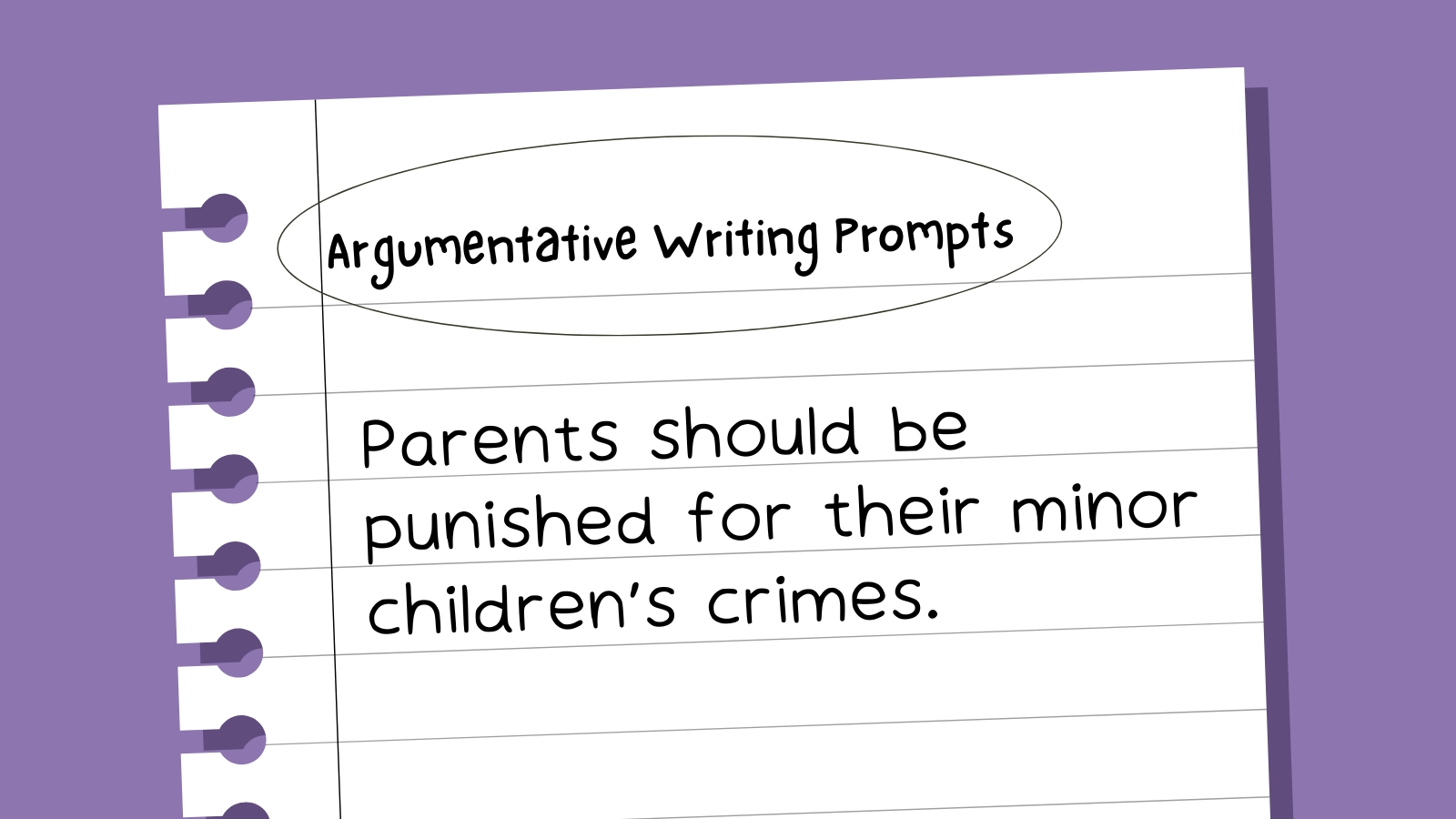
Writing a strong argumentative essay teaches students to make a case for their own point of view without relying on emotion or passion. These argumentative essay topics provide options for kids of all ages, including controversial subjects and some that are just for fun.
School and Education Argumentative Essay Topics
Science and history argumentative essay topics, life and ethics argumentative essay topics, social justice and civics argumentative essay topics, more argumentative essay topics, what’s the difference between argumentative and persuasive essays.
These two types of essays are similar, but there are some subtle and important differences .
- Author’s purpose: In an argumentative essay, your job is to simply convince the reader that the point of view you’re presenting is valid, even if it doesn’t change their mind. Persuasive essays seek to sway the reader to adopt your point of view over any others.
- Method: Argumentative essays rely heavily on well-researched facts and logical assertions. In a persuasive essay, the writer may use a blend of emotion and facts to win over the reader.
- Audience: Persuasive essays require a specific audience, since the writer must acknowledge and attempt to overcome their potential objections. The writer of an argumentative essay is simply making a statement, so knowing their audience is less important.
- Viewpoint: A persuasive essay writer should believe their point of view is the only correct one, and try to persuade the reader to agree. Argumentative essays acknowledge other points of view, but use reason and logic to argue that the writer’s point of view is best.
Persuasive and argumentative essay topics often overlap. The difference is in how the writer approaches the topic. When you assign one of the topics below as an argumentative essay, remind students to use research, reason, and logic to make a strong but dispassionate argument.
- Should physical education be part of the standard high school curriculum?
- Schools should require recommended vaccines for all students, with very limited exceptions.
- Should all students have the ability to attend college for free?
- What one class should all high schools students be required to take and pass in order to graduate?

- Do you think homework should be required, optional, or not given at all?
- Students should/should not be able to use their phones during the school day.
- Should schools have dress codes?
- If I could change one school rule, it would be …
- Is year-round school a good idea?
- Which is better, private schools or public schools?
- Should every student have to participate in athletics?
- Do you think schools should ban junk food from their cafeterias?
- Should students be required to volunteer in their communities?
- What is the most important school subject?
- Are letter grades helpful, or should we replace them with something else?
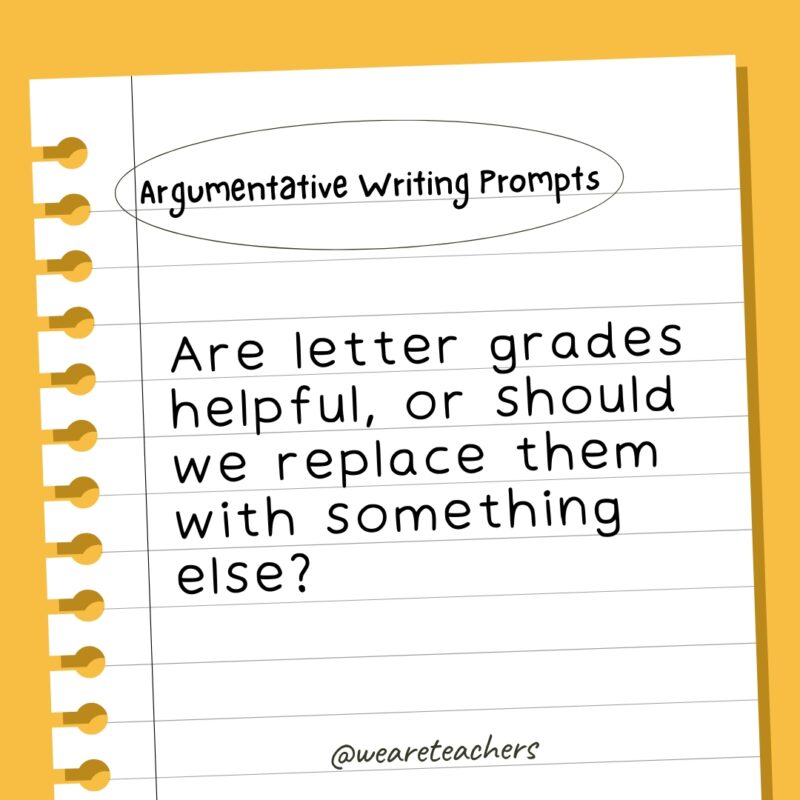
- Should schools be allowed to ban some books from their libraries?
- Which is better, book smarts or street smarts?
- Are single-gender schools better or worse for students?
- Are computers making teachers obsolete?
- Students who fail a test should be given a chance to take it again.
- Is it acceptable to use animals for experiments and research?
- Vaping is less harmful than smoking tobacco.
- Do we really learn anything from history, or does it just repeat itself over and over?
- Is it OK to keep animals in zoos?
- Should we ban plastic bags and bottles?
- Should we still consider Pluto a planet?

- It’s important to spend tax dollars exploring space, instead of on other things.
- Is there life on other planets?
- Who was the best/worst American president?
- Should vaccines be mandatory?
- Are GMOs more helpful than harmful?
- Is animal cloning ethical?
- Should human cloning be legal?
- Should we use stem cells from human embryos for scientific research?
- Is it better to provide drug addicts with treatment instead of punishment?
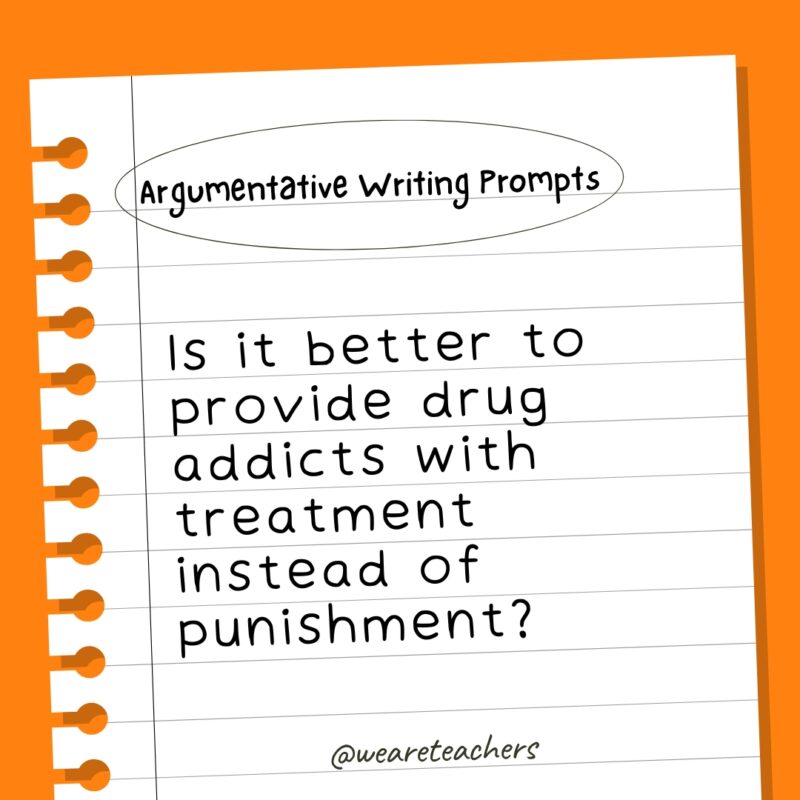
- Should we ban the use of fossil fuels?
- Can we truly do anything about human-caused global warming?
- Are electric vehicles better than gas-powered ones?
- Was life really better “back in the day”?
- Choose a foreign conflict (e.g., Vietnam or Afghanistan) and argue whether or not the United States was justified in getting involved.
- The most important challenge our country is currently facing is … (e.g., immigration, gun control, economy)
- Does social media do more harm than good?
- The best country in the world is …
- Are men and women treated equally?
- Is it better to be vegetarian/vegan than to eat meat?
- Should little kids be allowed to play competitive sports?
- Who faces more peer pressure, girls or boys?
- Should kids have set bedtimes or just go to bed whenever they’re sleepy?
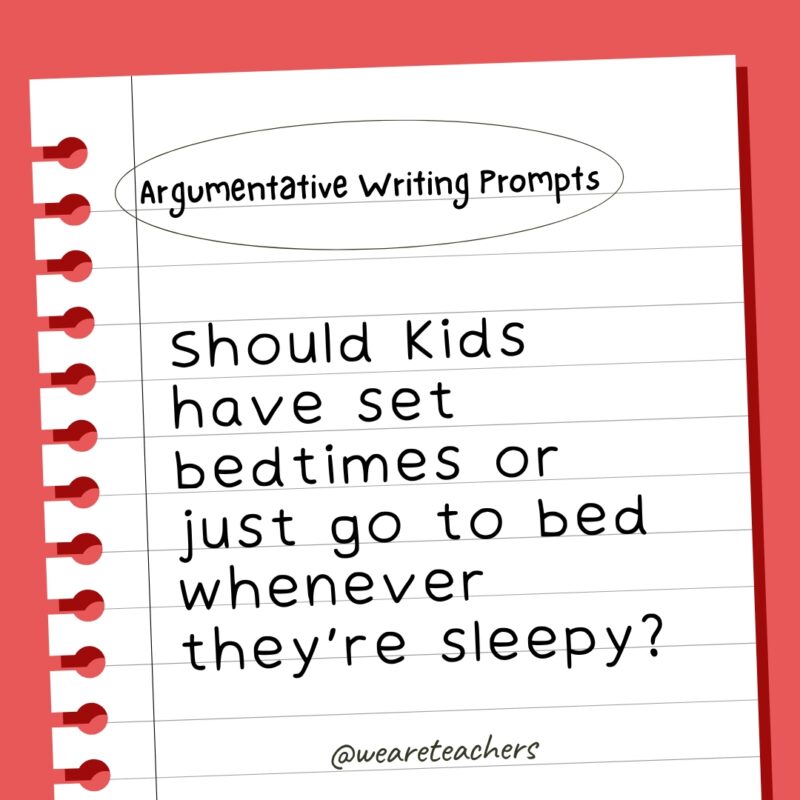
- Which is better, artificial Christmas trees or real ones?
- Playing violent video games is bad for kids and teens.
- Parents should track their kids using their cell phones.
- Are paper books better than e-books?
- All kids should play on the same sports teams, regardless of gender.
- All paper documents should be replaced with electronic versions.
- Is conflict necessary for change?
- Is war ever justified?
- A strong middle class is vital to the economy.
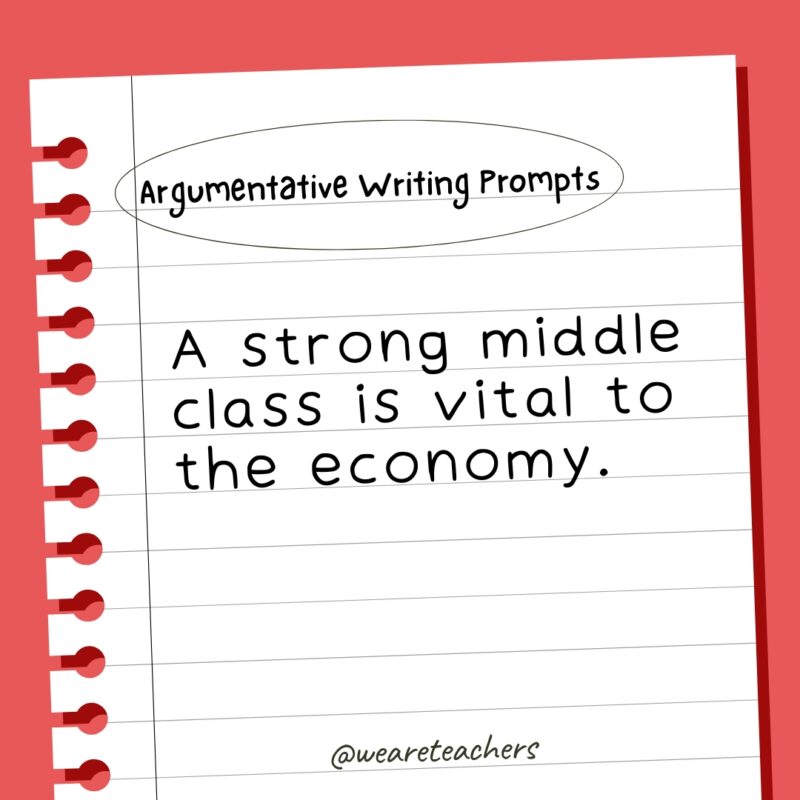
- Is the local minimum wage truly a living wage?
- Should we do away with gender-specific public bathrooms?
- Is a progressive income tax better than a flat tax?
- Capital punishment does/does not deter crime.
- Would it be better to legalize, tax, and regulate all drugs (including alcohol and cigarettes) instead of banning them?
- Parents should be punished for their minor children’s crimes.
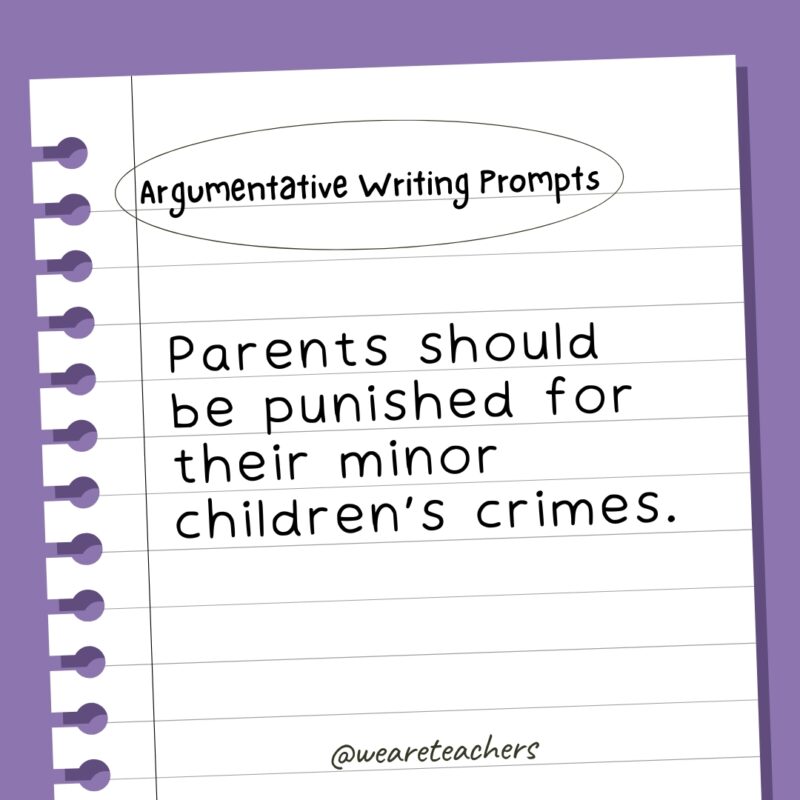
- The government should provide free internet access for every citizen.
- Is democracy the best form of government?
- Is capitalism the best form of economy?
- Should all Americans be required to vote?
- Should we change the minimum driving age in the United States?
- Do you think the government should find a way to provide free health care for everyone?
- School-age children should be allowed to vote.
- We should/should not abolish the electoral college.
- Are “Stand Your Ground” laws effective?
- Supreme Court judges should be appointed for fixed terms.
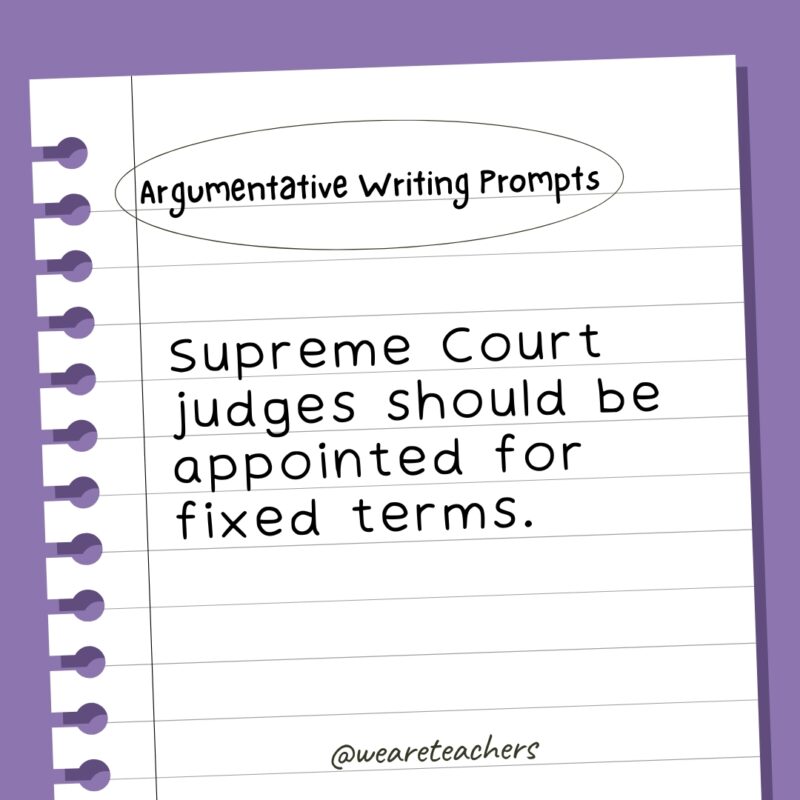
- Does segregation still exist in the United States?
- We should/should not continue building a wall between the United States and Mexico.
- Will stricter gun control laws help control mass shootings?
- Should we make the path to American citizenship easier?
- Is the American justice system inherently racist?
- Should we redirect some or all police force funding to social services?
- Should the United States implement a universal basic income?
- Choose a fictional character and explain why they should be the next president.
- What animal makes the best pet?
- Who is the world’s best athlete, present or past?
- Which is better, reading books or watching TV?
- Is a taco a sandwich?
- Should kids be allowed to stay up as late as they want?
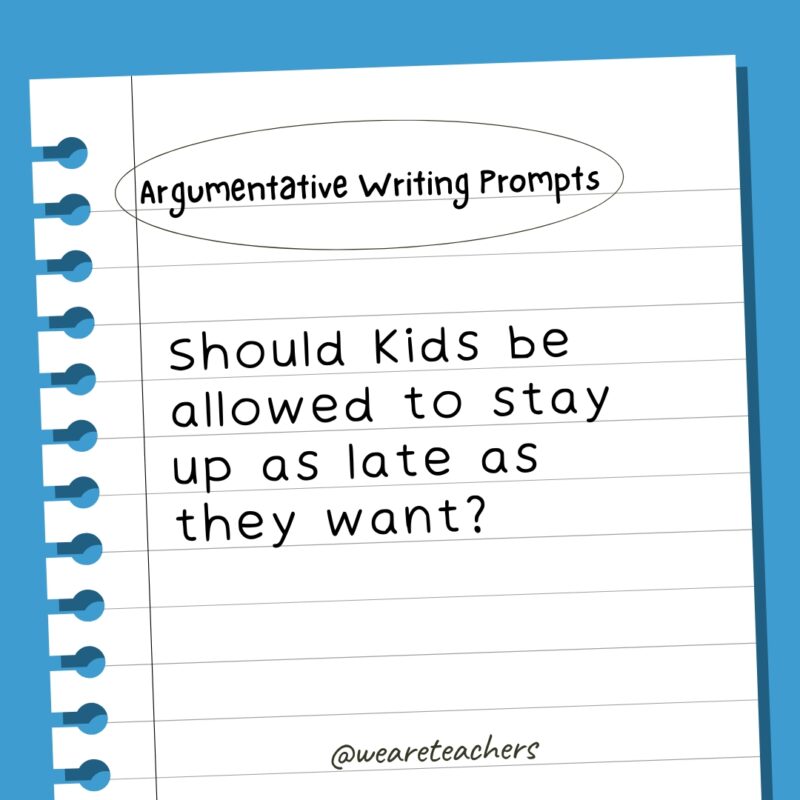
- What’s the best video game system?
- Kids shouldn’t have to go to school on their birthdays.
- Is video gaming a sport?
- Are beauty pageants sexist?
- Should kids get participation trophies for sports?
- Are stereotypes ever right?
- Is there any benefit to teaching proper grammar and spelling, or should we allow language to be descriptive instead of prescriptive?
- All teenagers should have part-time jobs.
- Should kids have limits on screen time?
- Is it better to read fiction or nonfiction?
- Should kids have to eat everything on their plate, even if they really don’t like something?
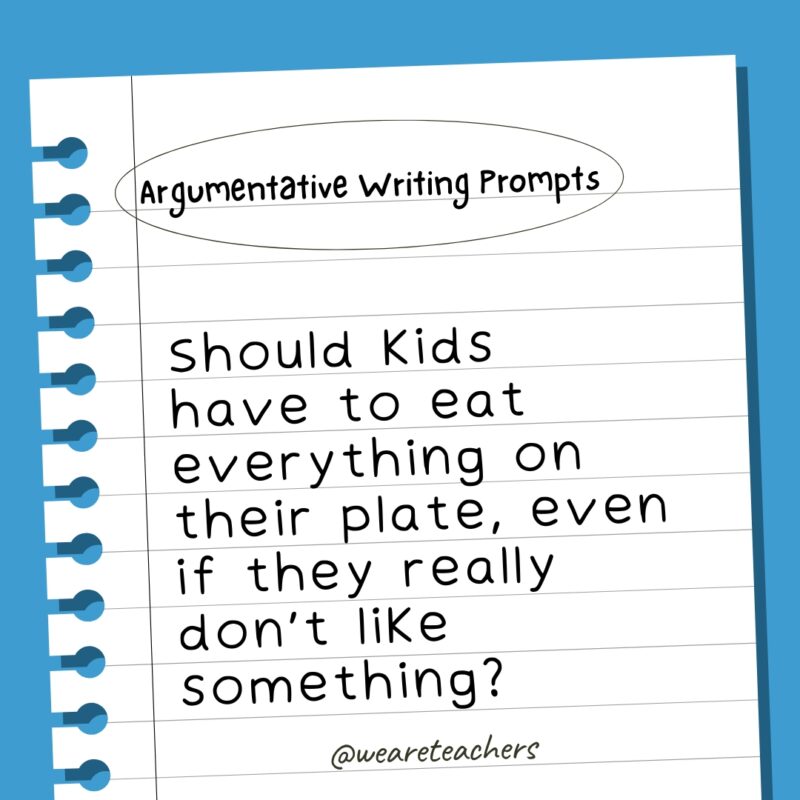
- Is it better to spend an hour a day reading or exercising?
- Is graffiti an act of vandalism or an art form?
- Should society hold celebrities to a high moral standard?
What are your favorite argumentative writing prompts? Come share your thoughts in the WeAreTeachers HELPLINE group on Facebook .
Also check out 100 intriguing cause and effect essay topics for students ..
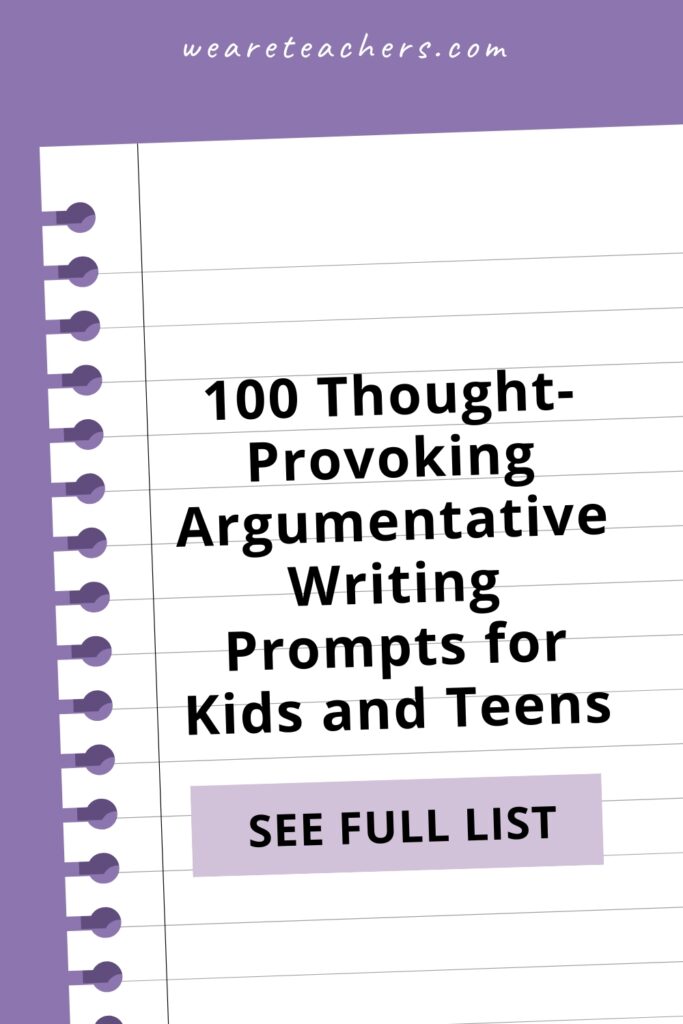
You Might Also Like
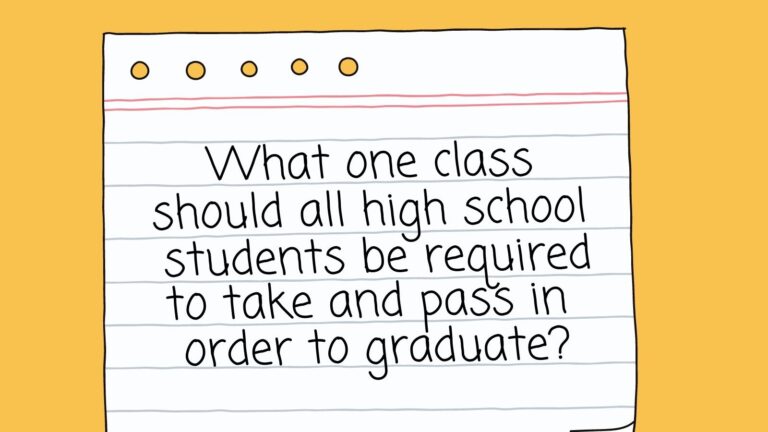
The Big List of Essay Topics for High School (120+ Ideas!)
Ideas to inspire every young writer! Continue Reading
Copyright © 2024. All rights reserved. 5335 Gate Parkway, Jacksonville, FL 32256
Argument & Thesis Statements
Main navigation, rhetorical mad libs.
In this activity, student groups experiment with different rhetorical appeals and strategies of argumentation (assigned randomly) to write a fake letter to a specific audience.
Rhetorical Analysis Thesis Workshops
These two activities are designed to introduce students to the idea of a thesis statement for a rhetorical analysis essay and provide structured peer feedback on their draft thesis statement.
The Empath, the Sweetheart, and the Skeptic
This innovative modification of a peer response activity asks students to pitch their thesis statements to each other in small groups, with respondents playing the roles of an active listener (empath), a "Sweetheart" (someone who really loves the thesis statement), and then the Skeptic (someone critical of the thesis statement).
Identifying Warrants or Assumptions
This activity is designed for students to work through the warrants and assumptions they may have for their arguments and identify possible gaps at the early stage of the research process. They can use this activity to consolidate the research process and locate useful sources and materials to formulate a coherent argument.
Evolving Your RA Argument
In this workshop, students apply the Evolving Thesis method to their RA pre-write, using the pre-write as a foundation to develop their first working thesis.
Visualizing the Argument
Through creative use of the whiteboard, this activity challenges students to think creatively about their developing research arguments to re-assess what they truly wanted to argue in their upcoming RBA.
The Elevator Pitch
This speaking activity encourages students to focus their argument by asking them to construct a pithy, brief "pitch" that they iteratively revise after delivering.
The Elevator Pitch with Peer Response
This activity helps students continue to develop their focus and argument for their RBAs. It is intended to show students that research is an ongoing process.
Find additional activities here:
Jumbo ‘Spectra’ Worksheets for Narrowing Topics and Locating Positions
Types of Argument
Reaching In to Reach Out to Skeptical Readers
ELA Activities and Resources
The Unique Argumentative Writing Group Game That Will Blow Up Your Class

Writing an argumentative essay can be a real challenge for students. Many times students find it difficult to understand how to write an argument, support their claims or craft a rebuttal. ARGUETROPIA , argumentative writing group game , is here to save the day!
Before getting down to writing that argumentative essay , start your students’ journey with ARGUETROPIA . It is a fun real life simulation of an imaginary city with reality inspired problems which the students have to solve in a competitive setting.
ARGUETROPIA is designed to be played with the entire class so no one is left behind. The students sharpen their argumentative and persuasion skills by finding solutions, writing arguments, constructing rebuttals and making motivated decisions.
How do you play it?
The students are split into 4 teams. Three of the teams are responsible for solving the problems presented on the task cards. One team decides which solution is the best for the city. The whole activity is packed with argument, rebuttal and motivation writing, offering a complete experience.

The teams receive an equal number of stars with the number of problem cards they will have to solve. If their solution is not voted by the Voters, they lose a star . If their solution is the voted one, they keep their current number of stars. The winner is the team that has the most stars after all problems are solved.

The game is easy to play and extremely flexible. You can choose from 20 possible problems and can fine tune the activity according to the needs of your students. The pack comes with ideas you can implement to modify the game in various manners.
ARGUETROPIA aids in cognitive and argumentative development in students. It increases the levels of engagement in class and it is an accessible tool for middle school and high school students.
Do you want to give it a go?
Over 200 teachers have already tried this engaging argumentative writing game and have reported amazing results. We gave away for free over 100 game packs and as we closed the promotional session, teachers wrote to us that they want more. So if you want to play ARGUETROPIA with your students in class today, we have a special discounted price only for you, our teacher friend.
Hurry up (because the game packs are selling like hot cakes) and get this engaging argumentative game now for your class!
Click on the picture below to download it from our TPT Store!
If you like it, please leave a quick review so that we know you had lots of fun learning argumentative writing in your class.

Stay in touch with us and get all the great resources you need for your ELA class!
Similar Posts

War, Refugees, Death and Identity: How To Tackle Sensitive Topics In English Class

4 Unbelievable Sentences Your Students Will Never Have to Say Ever Again
Leave a reply cancel reply.
Your email address will not be published. Required fields are marked *
Save my name, email, and website in this browser for the next time I comment.
Samantha in Secondary
10 Argumentative Writing Tasks That Are NOT Another Paper
September 13, 2021 by Samantha H.
When it comes to teaching argumentative writing, there are so many ways to allow students to demonstrate what they have learned. You absolutely do not need to write a full paper each time you’re teaching a specific skill. Consider alternative tasks to a paper such as letters, video, speeches, etc.
Here’s why you should consider scrapping the essay for your argumentative writing.
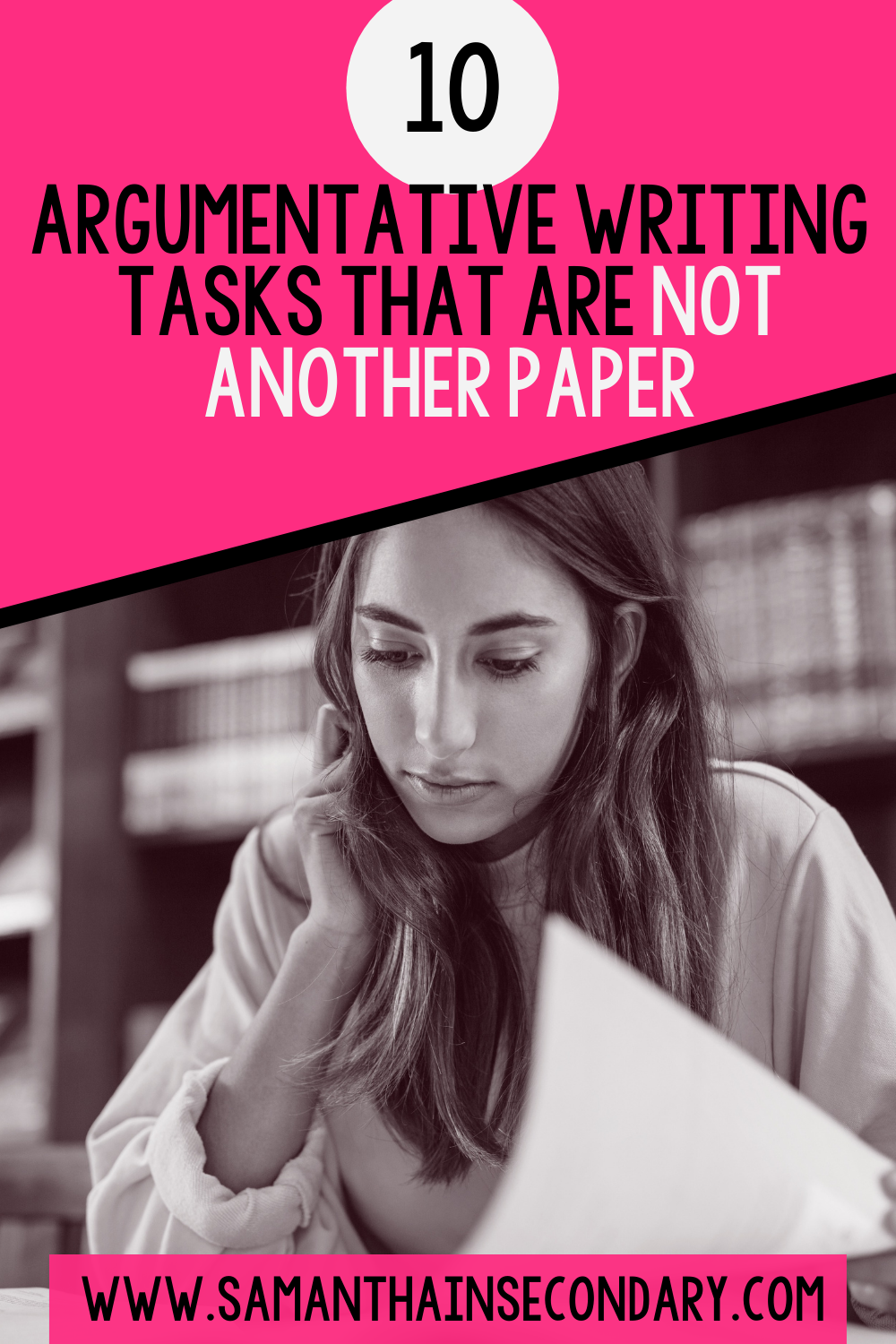
Reason One: Argumentative Writing Is a Genre, Not an Essay
What is it that you really want your students to get out of learning to write an argument?
The genre of argumentative writing can be broken down into these basics:
- The student investigates a topic.
- The student collects, generates, and evaluates the evidence.
- The student establishes a position in a concise manner.
But it doesn’t have to be a paper. If your assessment covers these basics, why not allow for some flexibility?
Reason Two: Your Students Could Use a Paper Break
When we assign papers, we often are not just looking for the content of the paper. We also grade for organization, fluency, spelling, punctuation, use of transition words, and a proper works cited page. Basically, we tend to grade for much more than just the content.
Some might say, “That’s just the way of English class.” But truthfully, this can be overwhelming for students. You might have heard the strategy to just grade for a few items off your rubric, but why not change the game entirely and let students work more creatively?
Reason Three: You Could Use a Paper Break
I’m always impressed when I see the work my students turn in, but I also like a little something different now and again. Giving my students creative options allows me a break from grading another essay with the same grading rubrics I’ve used over and over again. And I get to see a lot more insight into the way my students’ minds work and what they thrive in when I change up assessments.
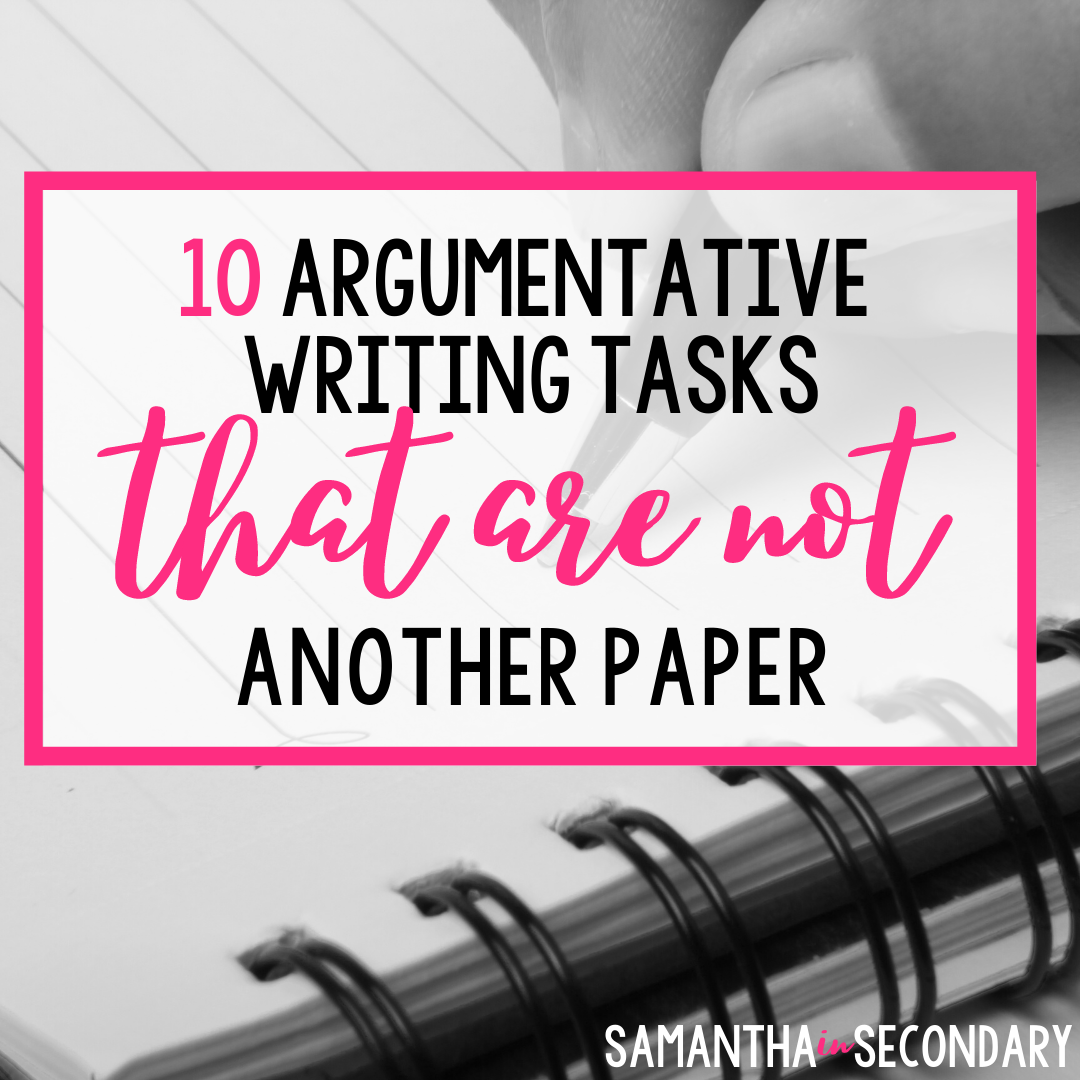
Here are 10 argumentative writing assessments that are NOT just another paper.
Have students write a letter to a stakeholder in the situation they are researching. This is a great way to demonstrate the impact of audience and purpose as well.
Some of your more literary students might love the challenge of arguing something in poetic form.
#3: Graphic Organizer
Sometimes all students need to understand the larger task at hand is to fill out a graphic organizer as if they were going to write a paper. This stops just short of writing the entire paper and allows students to go through the entire argumentative process while focusing on the big picture rather than the sometimes overwhelming task of crafting an entire paper.
#4: Public Service Announcement
Creating PSA’s is a great way to get your students engaged in the argumentative process.
Have your students create a poster with software like Canva or even Google Slides. This is a great way for students to share their information using a creative, 21st century medium.
#6: Podcast
Podcasts are an amazing way to enhance speaking and listening skills. What better way to have students share their arguments than by creating a podcast?
When crafting a blog, students can share what they’ve learned in an easy, relevant way.
Have your students preview examples before writing their own speech. A speech can be a powerful tool for students to hone their argumentative skills.
Many students love creating videos. You can have them create a basic video or challenge them to create a TikTok or Reel as if they were creating for social media.
#10: Infographic
Creating infographics is an intriguing way for students to transfer what they’ve learned to an eye-catching medium. Canva and Piktochart have great templates.
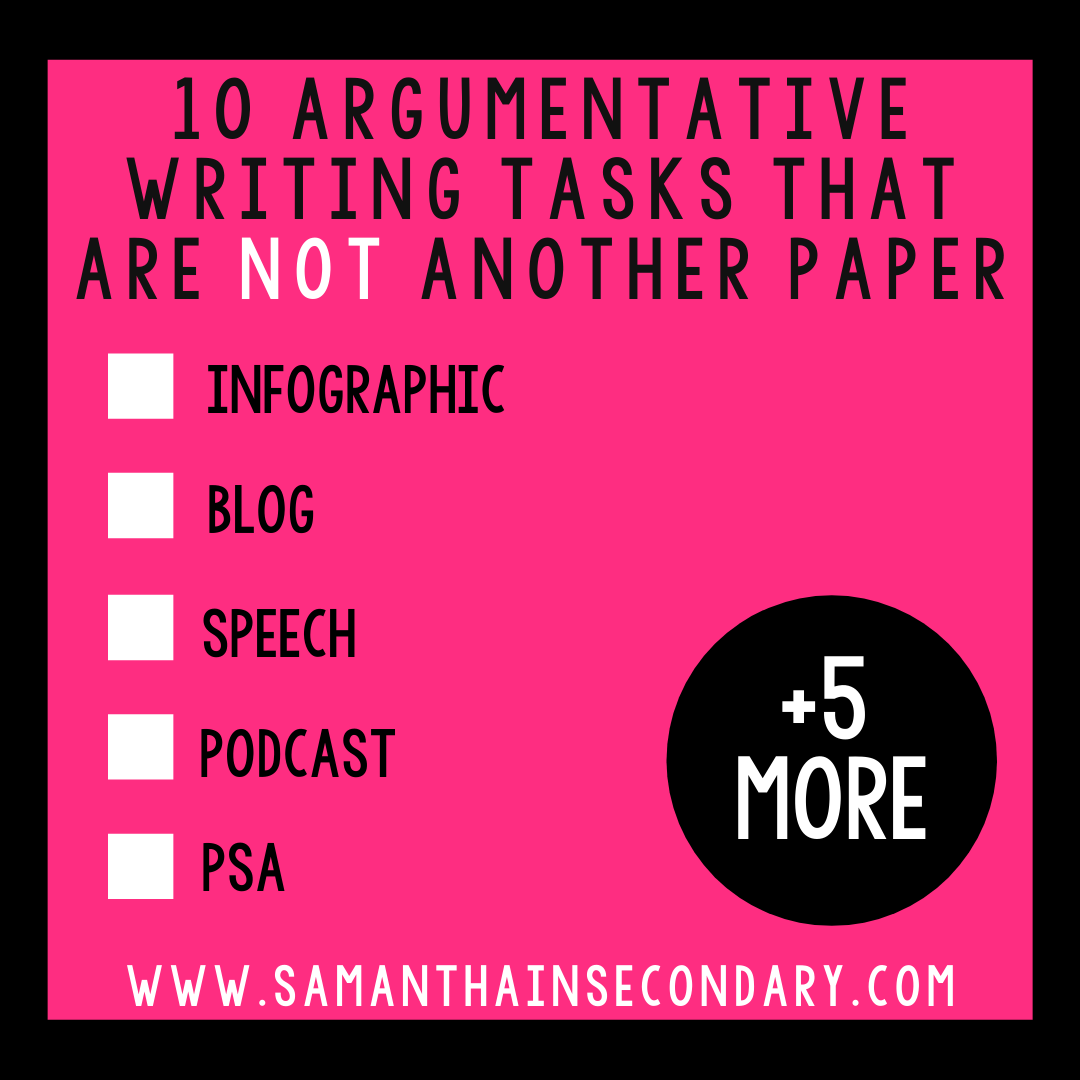
Get 50 Argumentative Writing Prompts!
Another thing I like to do is start each day in my argumentative unit with an interesting bell ringer. I’ve been using these argumentative writing prompts with a lot of success. Students love the variety and I love that they are practicing their skills every day!
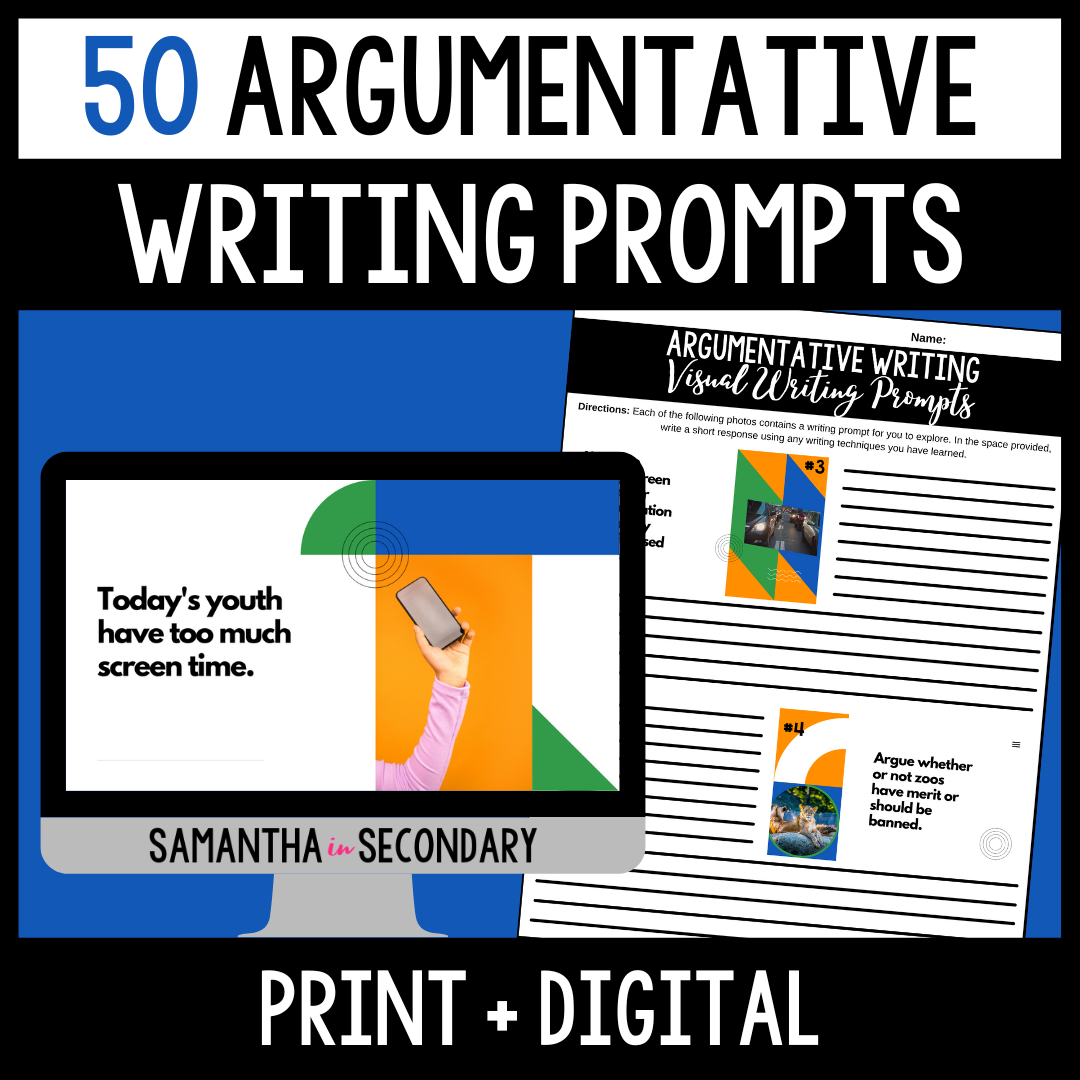
Have you tried any alternatives to an argumentative paper for your students? Let me know in the comments or continue the conversation with me over on IG and FB . I look forward to hearing what other ideas you love!
Happy teaching!

Subscribe to the newsletter to keep up to date on all things Samantha in Secondary.

In order to continue enjoying our site, we ask that you confirm your identity as a human. Thank you very much for your cooperation.
AP ® Lang teachers: looking to help your students improve their rhetorical analysis essays?
Coach Hall Writes
clear, concise rhetorical analysis instruction.
3 Argument Writing Activities my Students Loved!
December 30, 2023 by Beth Hall
As I’ve been prepping for my spring semester, I wanted to share 3 argument writing activities I gave my AP ® Lang students this semester that they genuinely enjoyed.
Argument Writing Activity 1: Teach the Teacher
I love when students write about “niche” concepts in their Q3 argument essays. I find it more interesting and more convincing than some of the more “obvious” topics.
However, I’ve noticed that students need to practice writing about topics of interest. For one, they need to be able to concisely and effectively provide background information so the reader understands the significance of the evidence.
Last year, I had a couple students select the same evidence for multiple prompts. They simply adapted the example to the prompt. While this apporach might not work for every student or all prompts, I noticed that those students seemed less stressed planning their essays. And, after writng about the same example in multiple ways, they really honed their writing skills.
So, for the “teach the teacher” assignment, I had my students select a topic of their choice and write an essay in which their goal was to inform, entertain, or persuade me. Knowing that I was their audience helped us revisit the concept of the rhetorical situation.
One of my classes loved it so much that they made me a “reading order.” With Google Classroom, I normally grade in alphabetical order, but they made me a “playlist” of sorts so that their chosen topics could have maximum effect. It was interesting to hear the class rationalization for the order. Some of the topics were humorous to read consecutively. They also wanted to balance the “heavy” topics with the lighthearted ones.
As an extension of this activity, you could have students make a presentation to teach the class as well.
This year, I had my students write shorter essays, 4-5 paragraphs (more like an exam length essay,) but in the past, I’ve done this assignment as a full research paper to help students practice synthesis and argument skills that they will need in college. Honestly, either option works well. I change my approach based on students’ needs and my work load.
Argument Writing Activity 2: Independent Reading
I don’t teach a full-length novel in. my AP Lang classes. (Our students cover a variety of full-length texts in their other classes.)
However, I’ve noticed that most of my students do not read outside of class. I get it. They have activities, jobs, responsibilities, etc.
But, I also know that students need specific examples to write an effective argument essay, and some students struggle with generating effective evidence.
An independent reading assignment is an argument writing activity that meets both needs. I provide students with a list of recommended books (nonfiction titles from my class library and our school library,) but I also allow them to request a book if there is one they would prefer instead.
Student choice builds investment in the activity.
Now you might be wondering what my students did besides just reading the book.
Here are some ideas:
- Vocab Lists: I had students find 10 vocab words in their books. They had to define the word and include the part of speech. They also had to write the sentence from the book that contained the word as well as a sentence of their own that included the word.
- Rhetorical Analysis: I had my students select a short passage (approximately 2 paragraphs – a page) to analyze. They had to identify one rheotrical choice in the passage they selected and explain how the choice contributed to the message, argument, or purpose.
- Make your own Q3 prompt: This was my favorite part of the assignment. I had my students write their own Q3 prompt and then write a thesis and body paragraph in response to their prompt. The body paragraph had to include something from the book as evidence. Students had to make sure they provided enough background for their evidence to make sense, plus adequate commentary. Some students used an important quote from the book in their prompt. Other students identified a broader issue and found a quote from another source to use as the basis of their prompt. I coached my students on how to use the stable wording and offered to be a sounding board if needed. Overall, I was really impressed with the prompts they created and how they used their books as evidence.
Argument Writing Activity 3: Convince the Class
Do you remember that meme with the teacher sitting by the table sipping coffee with a sign that had a topic and said “change my mind?”
That meme plus a conversation with my husband inspired this assignment.
I don’t know much about college football. We live in Arkansas, so our seasons are usually pretty disappointing 😂
However, I always wondered why the playoff selection process was the way it was. I’m not an expert, but it seems like a bracket system would be more engaging, especially since so many top players now opt out of the bowl games to be healthy for the draft.
Apparently this is one my husband’s “Roman Empires” as the TikTok trend goes. (A Roman Empire is a topic you think about regularly.) And as such, he has a whole solution to revamp the current system. I must admit it was pretty convincing.
So, I thought I could turn this into an assignment by having my students assert a position on a topic they are passionate about, even if that topic might not seem very sophisticated or academic.
Some of the football players in the class loved the idea of having to pitch a solution to revamp College Football, especially after FSU didn’t make it.
Not all students enjoy sports, let alone football, so here are some other possible “debate” topics or writing prompts.
- Should schools reduce to a 4-day week?
- Has TikTok shop ruined the FYP?
- What’s a conspiracy theory that you find plausible and why?
- Has Taylor Swift helped change the NFL’s image?
- Is cheerleading a sport? (Could replace with other topics likes band, dance, bowling, etc.)
- What order should you watch the Star Wars or Marvel movies in?
- What is your Roman Empire and why?
A couple of the topics above could lend themselves to the “2019 overrated prompt” as well (i.e. TikTok shop is overrated or the College Football Playoffs are overrated, etc.)
Keep in mind that each school environment is different, so not all of the above ideas will be a good fit for each school. Plus, students might have ideas of their own as well.
For more argument writing activities, such as a March Madness style bracket, check out this resource!
For more tips about teaching argument writing, check out this blog post!
AP® Lang Teachers
Looking to help your students improve their rhetorical analysis essays?
[…] Looking for ways to turn these popular books for high schoolers into an argument essay assignment? Check out this post for some ideas! […]
Latest on Instagram

Shop My TPT Store
Argumentative Writing Prompts - Text Based Essay Topics - Test Prep Activities

- PDF Frequently assigned in Easel ,
- Google Apps™
What educators are saying
Also included in.
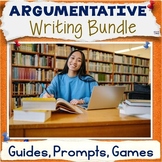
Description
Do you want to be the best teacher ? Would you like to give your students argumentative essay writing prompts they will enjoy? Is one of your goals to encourage argument building skills by using easy argumentative essay topics? Would you be interested in having a solid starting point for essays by offering textual information that complete the covered argumentative writing topics?
If you found something that gave you all these benefits, would you want to get started with it right away?
Think about what a difference it will make when you start using these text based argumentative essay writing prompts in your class! They include:
- 15 argumentative essay writing prompts for middle school based on informational texts with ample writing space
- Argumentative essay writing rubric and Student Grading Form with Teacher's Appreciation section
- Google Slides version of the argumentative essay topics for students
- EASEL by TPT version of the argumentative essay writing prompts
Argumentative essay topics for students:
2. Mosquitoes
4. Space Stations
5. National Symbols
6. … 10 and more! Click on the PREVIEW to take a look at all the argumentative writing topics.
Because of multitude of real world argumentative writing topics, you can select the essay prompts that your students find interesting which means a higher level of engagement in class.
The informational texts come with a wealth of detail your students can use as a research starting point which means that writing the argumentative essay will be easier and faster.
The standards based essay rubric will give you an accurate evaluation on your students' performance so you can offer valuable feedback for improving their writing and getting better at knowing how to write an argumentative essay.
Just imagine how you will feel when you start to get the benefits and results from this resource right in your class!
Are you afraid that these argumentative essay writing activities will not match the needs of your students? I understand exactly what you feel. Don’t worry! Just try it and if you find this resource not suitable for your class, just email me at [email protected] and I’ll get you a full refund.
⭐⭐⭐⭐⭐ Christine M. has tried these argumentative essay writing prompts in her class and said, “What a great resource for teaching argumentative . My students were really engage d during this activity. Thank you for taking the time to create a great product; it was such a time saver ! Thank you!"
Why don’t you give it a try? Click on the “Add one to cart” green button and you can use it right away!
Are you looking for something else? No problem! Check out these engaging resources that your students will love:
⭐ Argumentative Essay Writing Guide - Outline, Format, Prompts
⭐ Argument Writing - Guide, Templates, Argumentative Essay Topics
⭐ Argumentative Writing Game For Groups - ARGUETROPIA
Questions & Answers
Ela by snappy den.
- We're hiring
- Help & FAQ
- Privacy policy
- Student privacy
- Terms of service
- Tell us what you think

COMMENTS
There are many engaging activities to use when teaching argumentation and persuasion beyond the classic essay. While the argumentative essay can certainly be effective, try something new with one of these 6 engaging activities. Your students will be excited and eager to apply argumentation and persuasion in the classroom and beyond.
Though I was desperate to get into my classroom, I, rather begrudgingly, attended one of the mandatory sessions. This session was on "Gaming in the Classroom: Increasing Student Engagement". ... The Writing Process, Writing Mini-lessons Guest User January 23, 2018 Argument Writing, The Argument Essay, Argument Activities, Practicing ...
Persuasion Map: Students can use this online interactive tool to map out an argument for their persuasive essay.: Persuasive Strategy Presentation: This handy PowerPoint presentation helps students master the definition of each strategy used in persuasive writing.: Check the Strategies: Students can apply what they know about persuasive writing strategies by evaluating a persuasive piece and ...
The Persuasion Map is an interactive graphic organizer that enables students to map out their arguments for a persuasive essay or debate. Students begin by determining their goal or thesis. They then identify three reasons to support their argument, and three facts or examples to validate each reason. The map graphic in the upper right-hand ...
4. Identify claims and evidence. Related Article Tim Lahan. The Common Core Standards put argument front and center in American education, and even young readers are now expected to be able to ...
Table of Contents. Persuasive Writing Lesson Plan 1: Identify the Key Features of Adverts. Persuasive Writing Lesson Plan 2: Analyze an Advert. Persuasive Writing Lesson Plan 3: Plan an Advertisement. Persuasive Writing Lesson Plan 4: Create the Advertisement. Persuasive Writing Lesson Plan 5: Further Practice in the Art of Persuasion.
Our students are already good at arguing, but we can lean into that and embrace it to inspire persuasive essay writing and speaking. Here are some games and activities to try out with your next persuasive unit in secondary ELA! PowerPoint Parties: Straight from TikTok. In their pure sense, PowerPoint Parties started becoming popular due to ...
In " 10 Ways to Teach Argument-Writing With The New York Times ," you'll find resources for: Exploring the role of a newspaper opinion section. Understanding the difference between fact and ...
Extending: Adding commentary to the conversation on the issue at hand. Countering: Addressing opposing arguments with valid solutions. Teaching students to identify these moves in writing is an effective way to improve reading comprehension, especially of nonfiction articles. Furthermore, teaching students to use these moves in their own ...
Step 4: Reply to other students. One of the things that make our comment section special is that students from all over the world participate. Before you comment, read what other students have ...
Here are Melissa's simple steps for using this debate-style discussion strategy in your classroom: Give students a thought-provoking or humorous prompt. Play music as students think, research, jot notes, and (if possible) walk around the room. Stop the music and have students get into groups of two or three.
If you're a writing teacher in grades 7-12 and you'd like a classroom-ready unit like the one described above, including mini-lessons, sample essays, and a library of high-interest online articles to use for gathering evidence, take a look at my Argumentative Writing unit. Just click on the image below and you'll be taken to a page where you can read more and see a detailed preview of ...
100 Thought-Provoking Argumentative Writing Prompts for Kids and Teens. Practice making well-reasoned arguments using research and facts. Writing a strong argumentative essay teaches students to make a case for their own point of view without relying on emotion or passion. These argumentative essay topics provide options for kids of all ages ...
Identifying Warrants or Assumptions. This activity is designed for students to work through the warrants and assumptions they may have for their arguments and identify possible gaps at the early stage of the research process. They can use this activity to consolidate the research process and locate useful sources and materials to formulate a ...
The game is easy to play and extremely flexible. You can choose from 20 possible problems and can fine tune the activity according to the needs of your students. The pack comes with ideas you can implement to modify the game in various manners. ARGUETROPIA aids in cognitive and argumentative development in students.
Argumentative Essay Practice activities & prompts for: claims, supporting arguments, counter-arguments, & refutations. Brainstorming: what's your opinion about ... Reviewing the counter-argument paragraph Some people believe that cell-phones distract students in class and teachers can't control what they are working on. However, teachers ...
Persuasive writing is a form of writing where the writer attempts to convince or persuade the audience to adopt a particular point of view or take a specific action by presenting logical reasoning, supporting evidence, and compelling arguments. This type of writing encourages students to formulate a clear viewpoint on a particular topic ...
September 13, 2021 by Samantha H. When it comes to teaching argumentative writing, there are so many ways to allow students to demonstrate what they have learned. You absolutely do not need to write a full paper each time you're teaching a specific skill. Consider alternative tasks to a paper such as letters, video, speeches, etc.
This activity is designed to help students differentiate between Argumentative, Explanatory and Narrative essay/story Writing. This is a great lesson for Common Core Standards and test prep. With your purchase, you get 12 sorting cards (4 cards for each writing type).
An entire mini lesson & activity to actively practice using the revision process of a 3 paragraph, argument essay with an introduction, body and conclusion. This lesson includes: 1. Set up and directions for teachers to implement this mini lesson into a lesson plan (includes directions, duration, and how to use the accompanying worksheets) 2.
She has extensive experience creating & teaching curricula in college level education, history, English, business and marketing. Argumentative essays are a way for students to analyze the pros and ...
Argument Writing Activity 1: Teach the Teacher. I love when students write about "niche" concepts in their Q3 argument essays. I find it more interesting and more convincing than some of the more "obvious" topics. However, I've noticed that students need to practice writing about topics of interest. For one, they need to be able to ...
Argumentative essay writing rubric and Student Grading Form with Teacher's Appreciation section; Google Slides version of the argumentative essay topics for students; EASEL by TPT version of the argumentative essay writing prompts; Argumentative essay topics for students: 1. Wordle. 2. Mosquitoes. 3. Candies. 4. Space Stations. 5. National ...